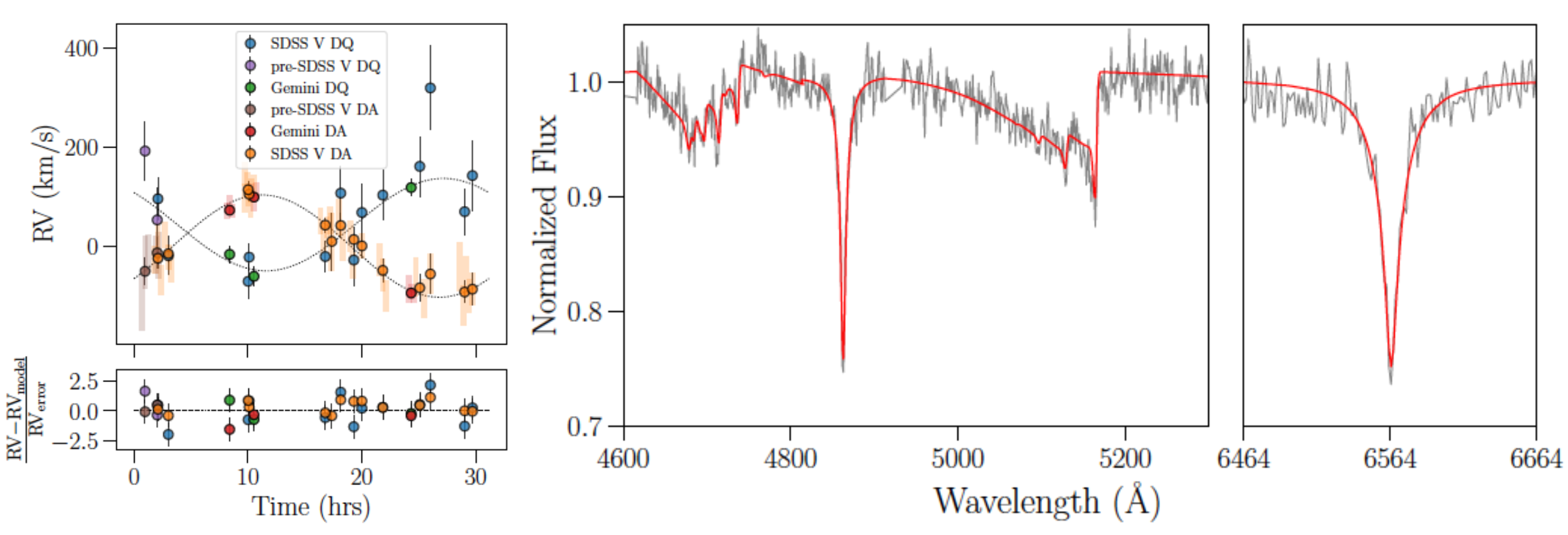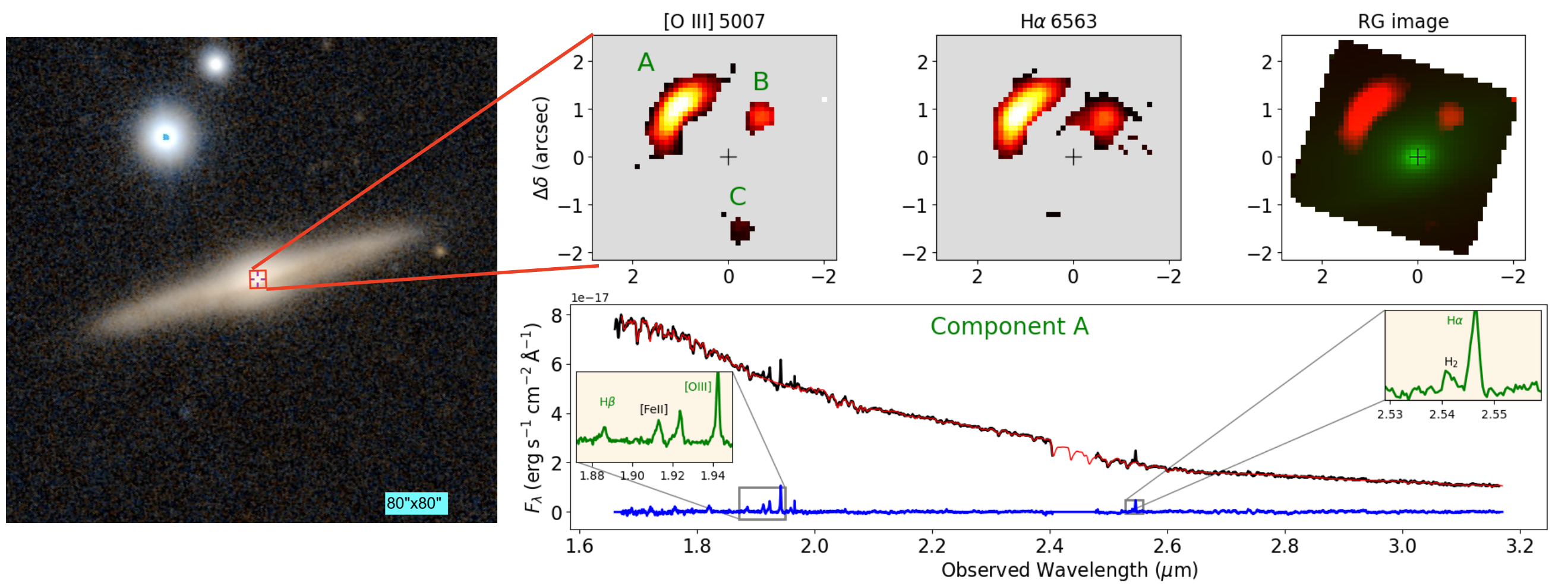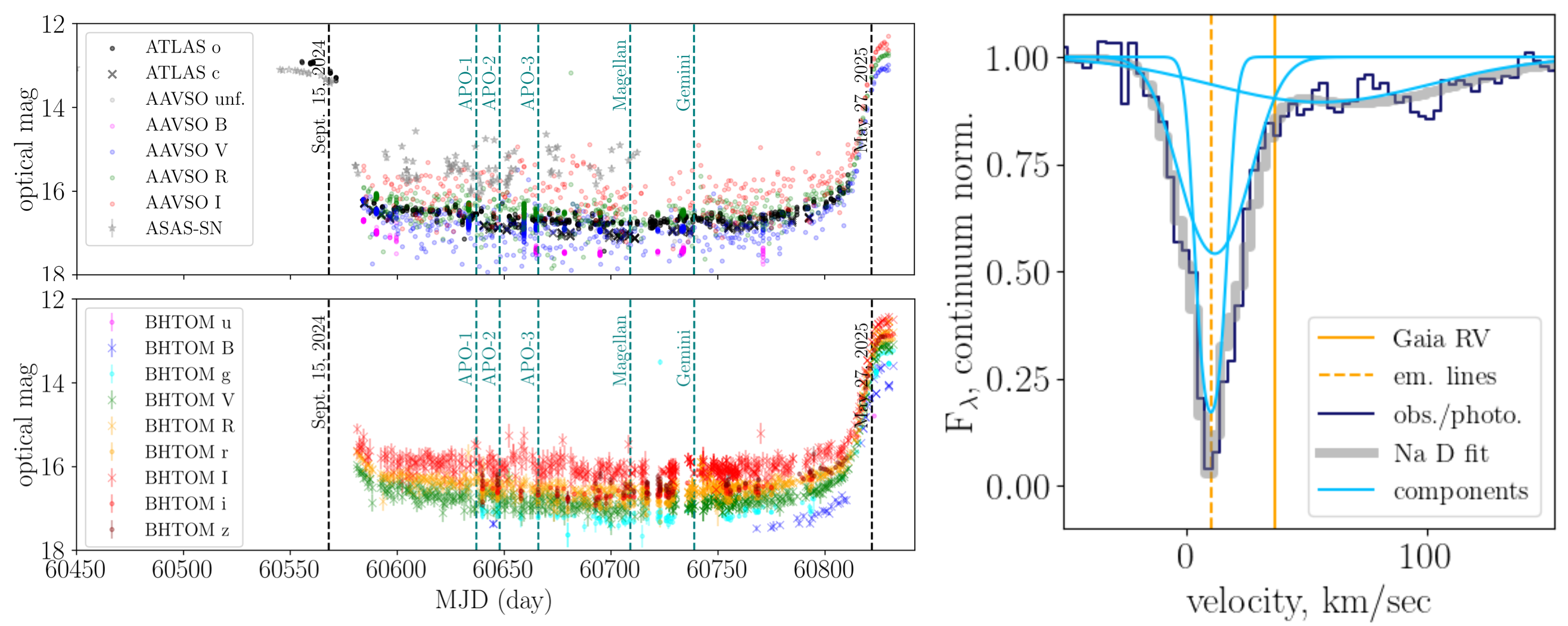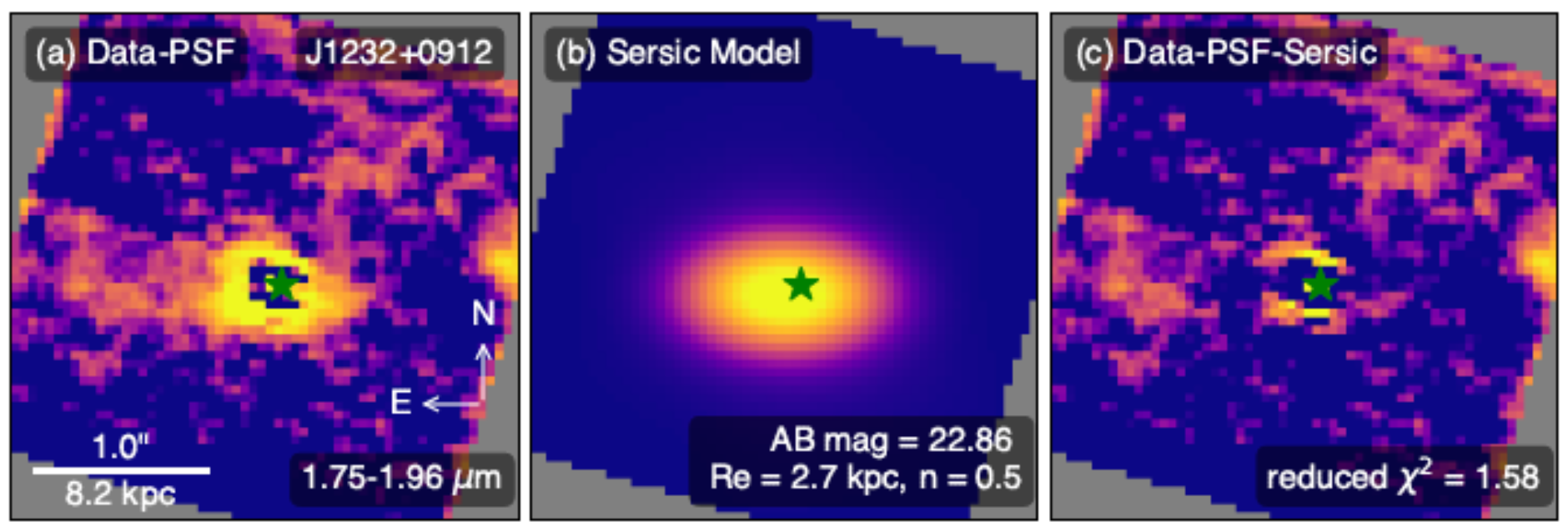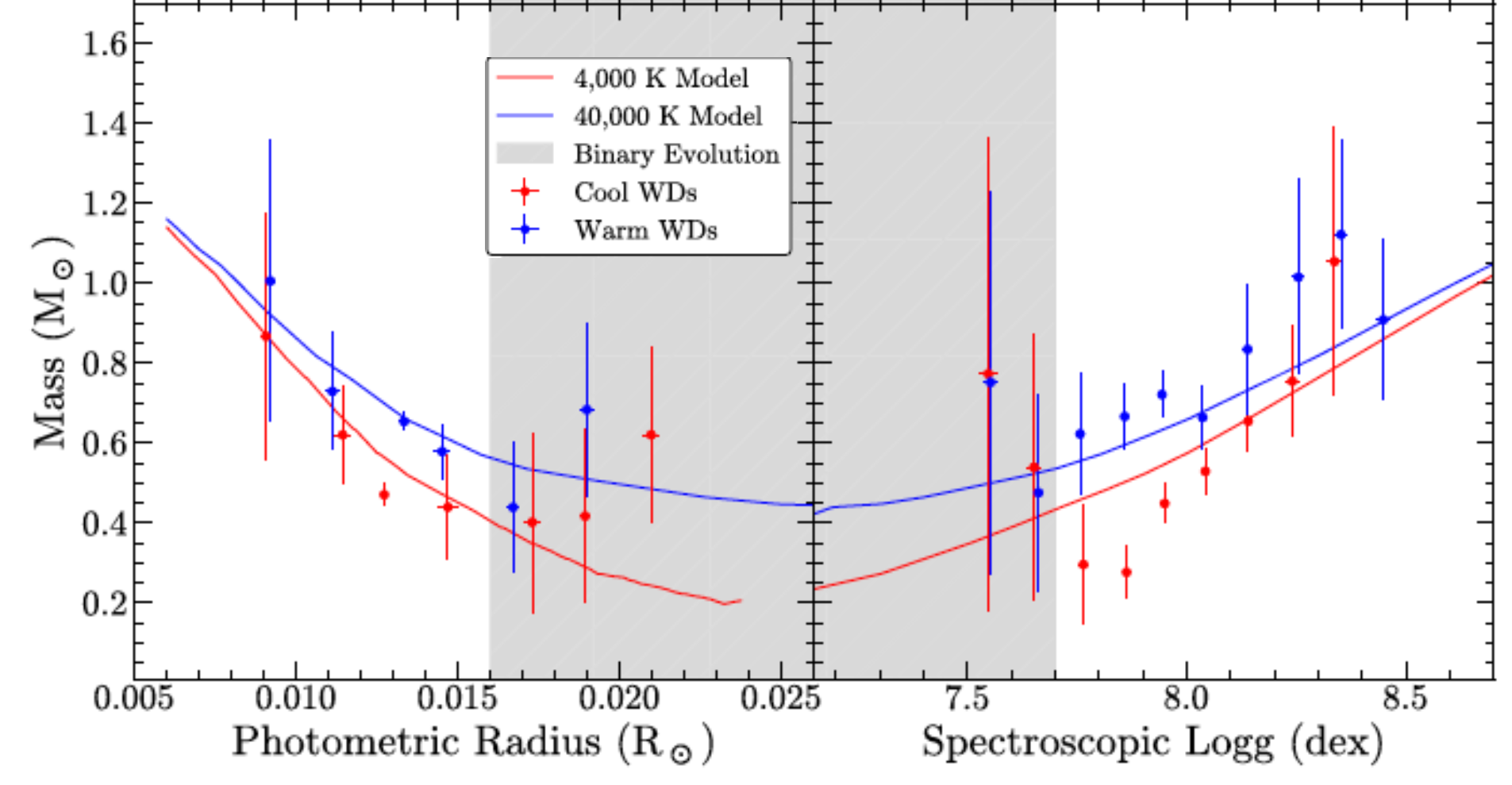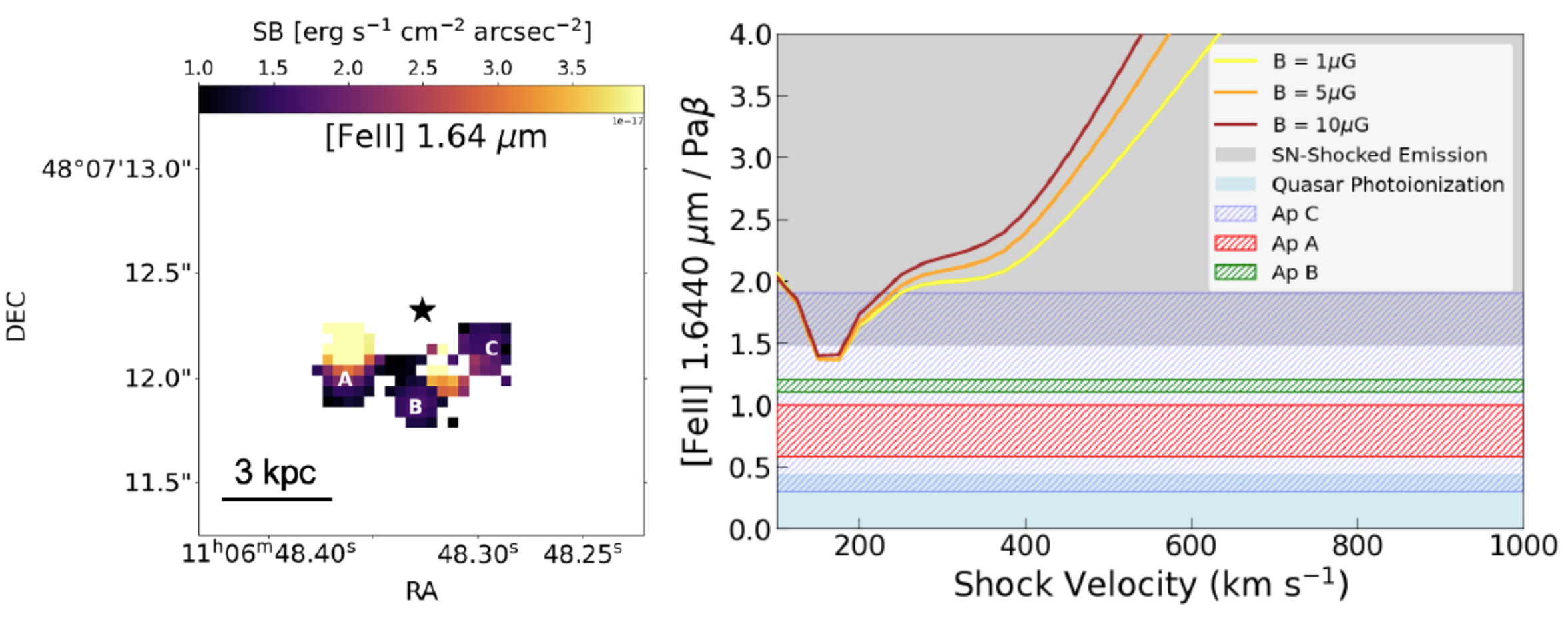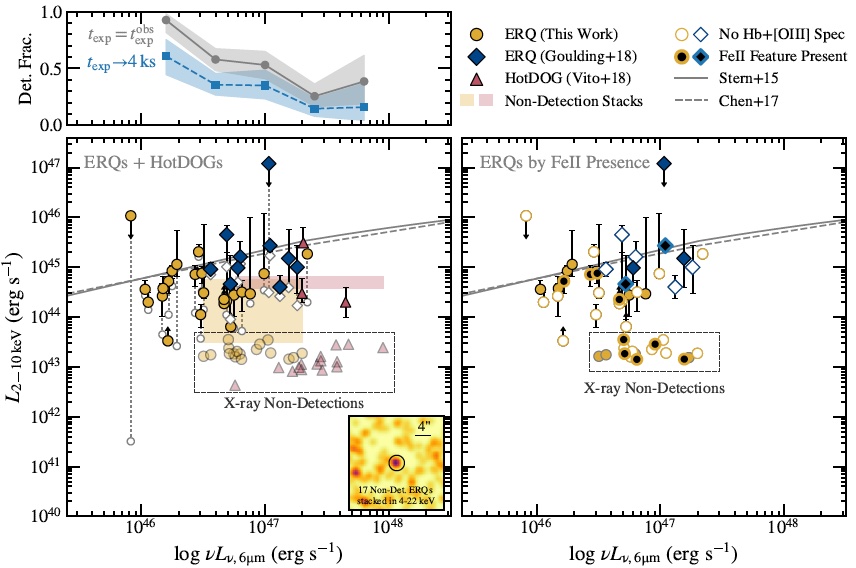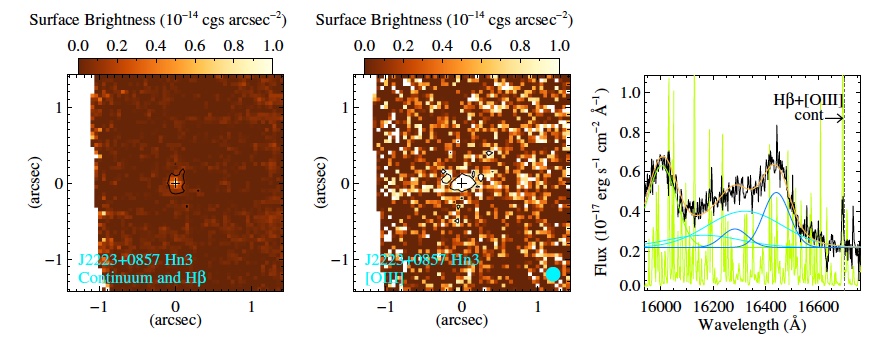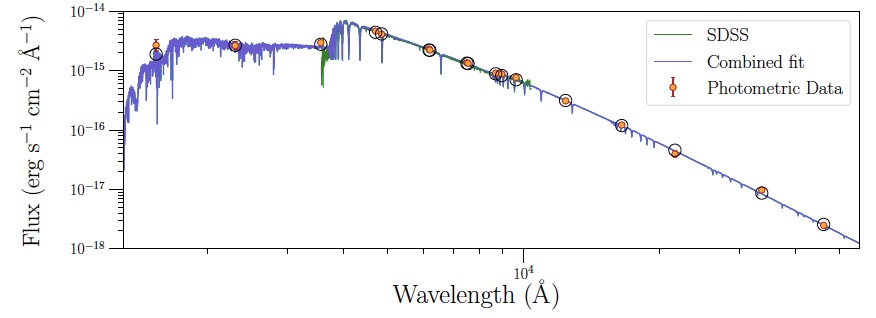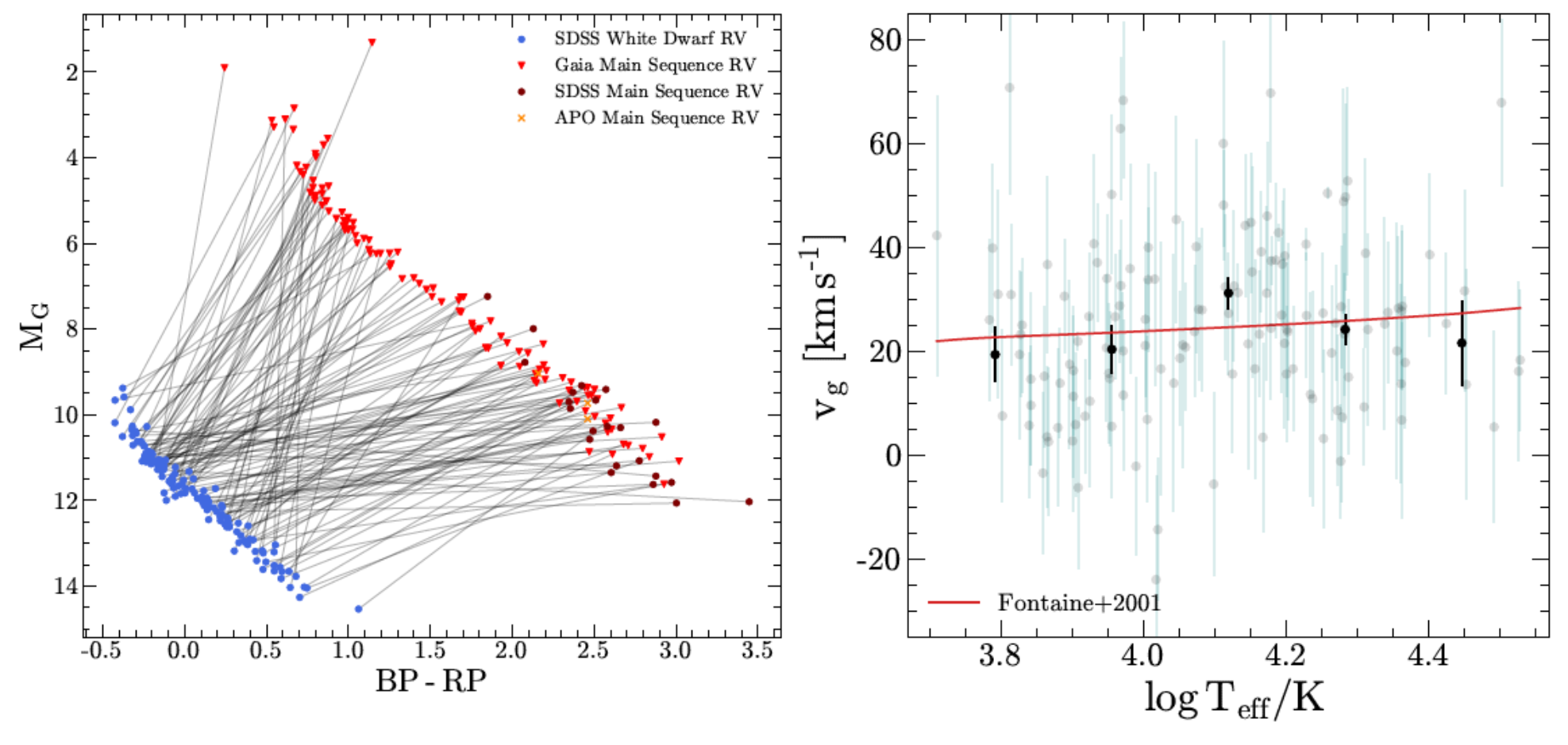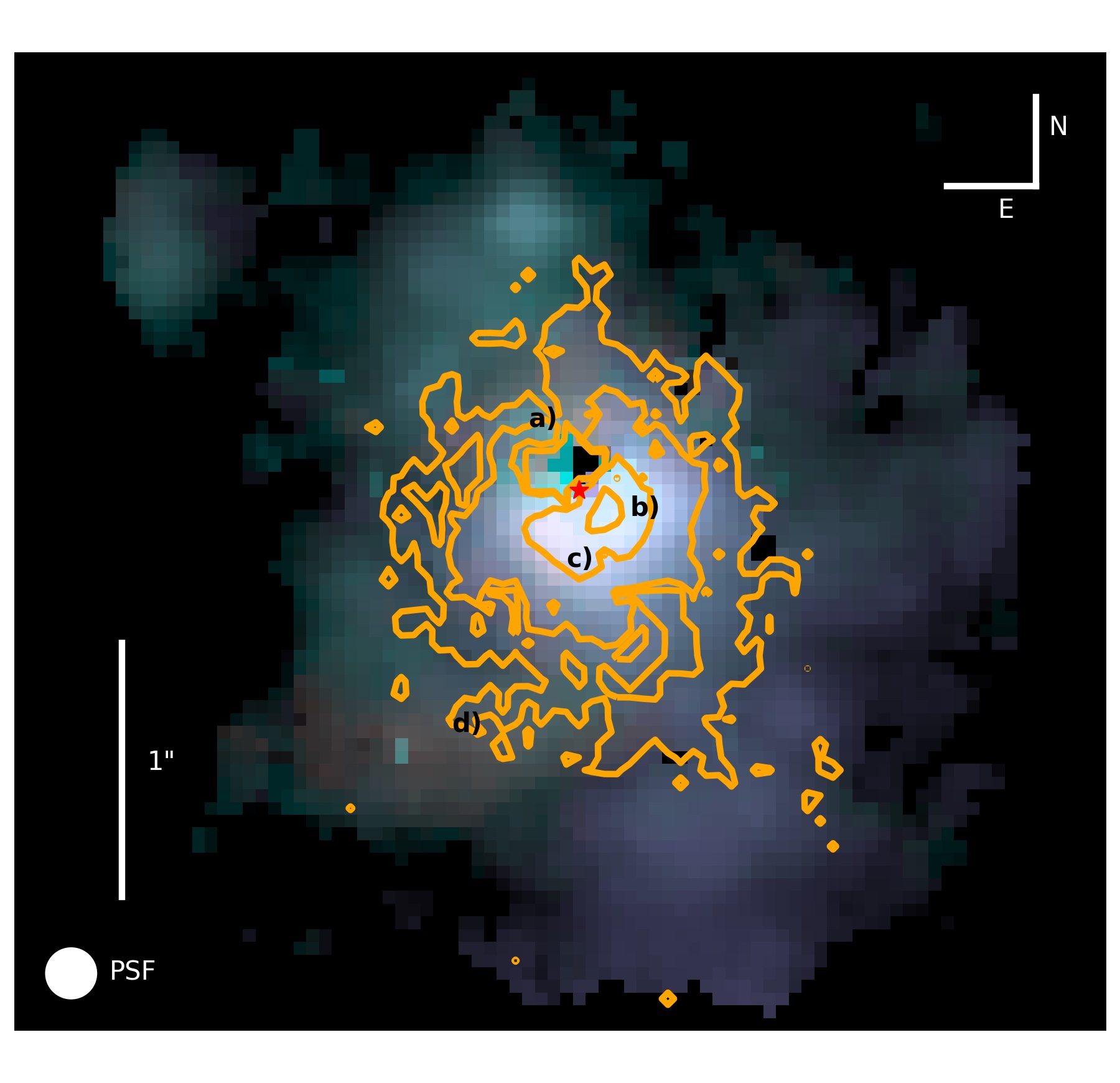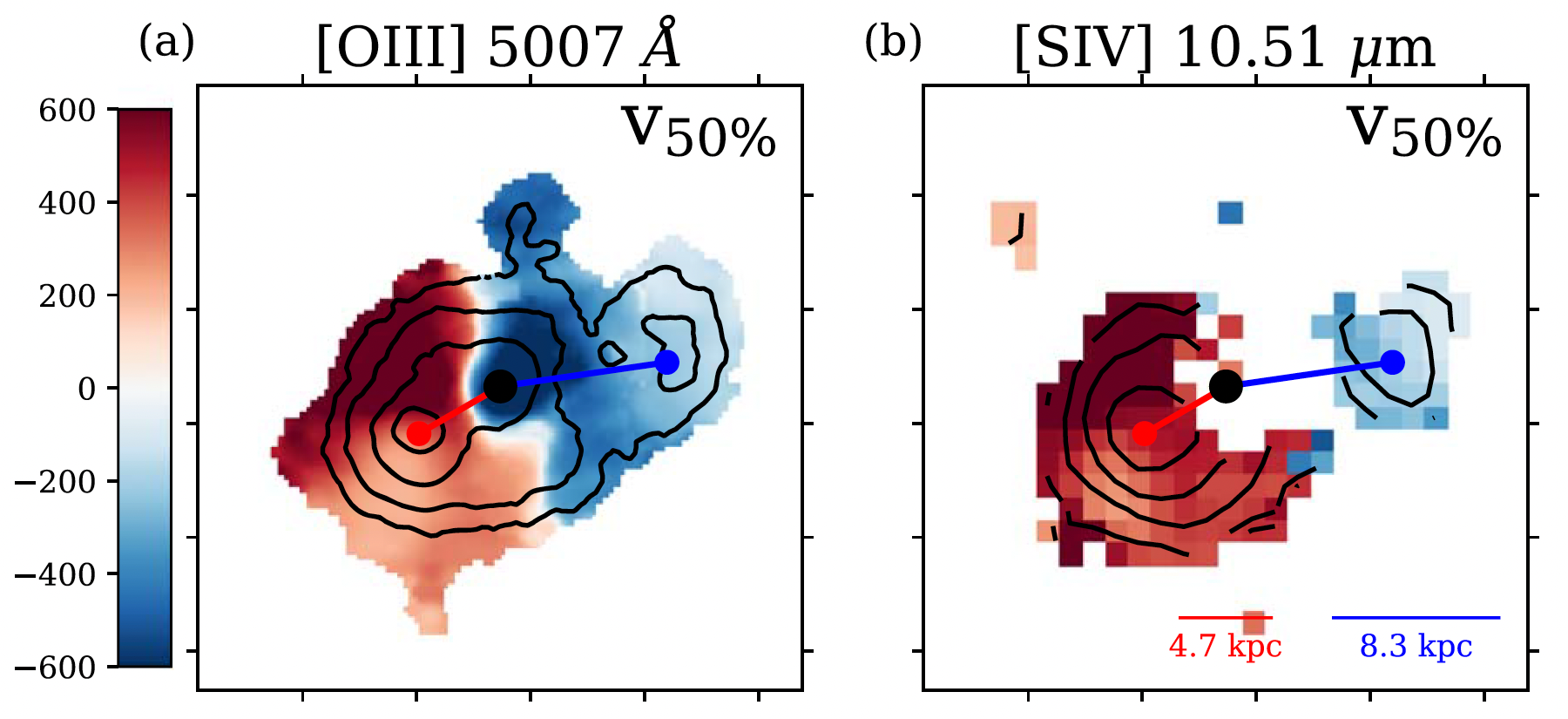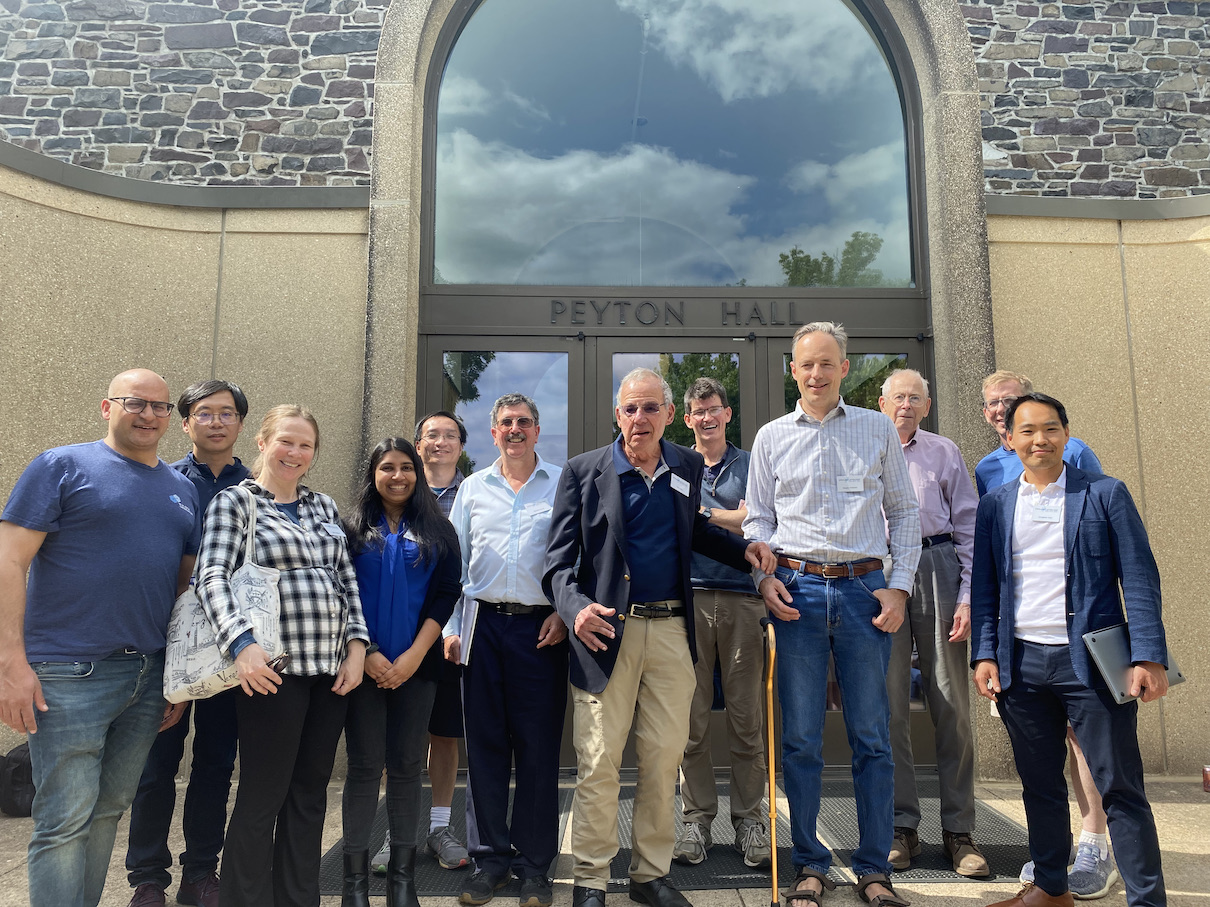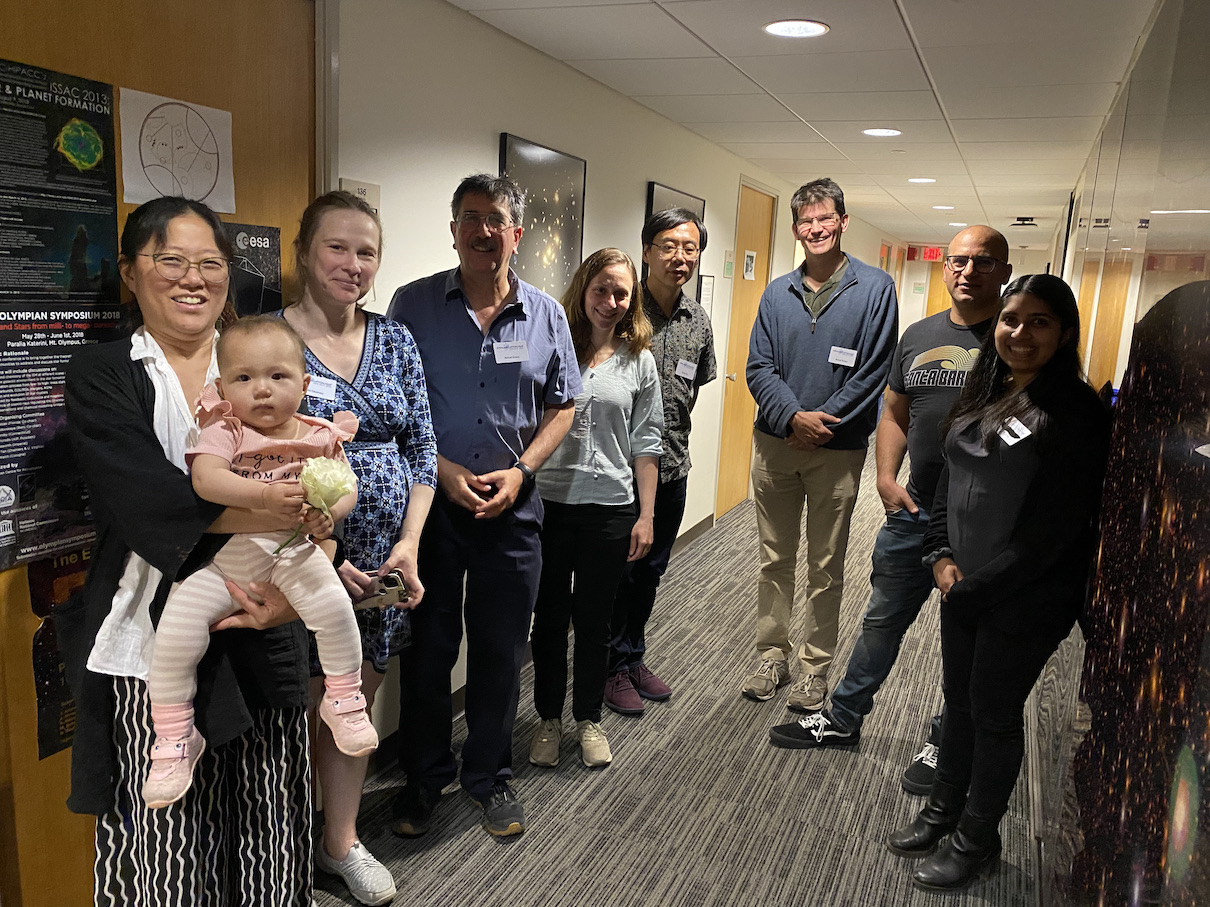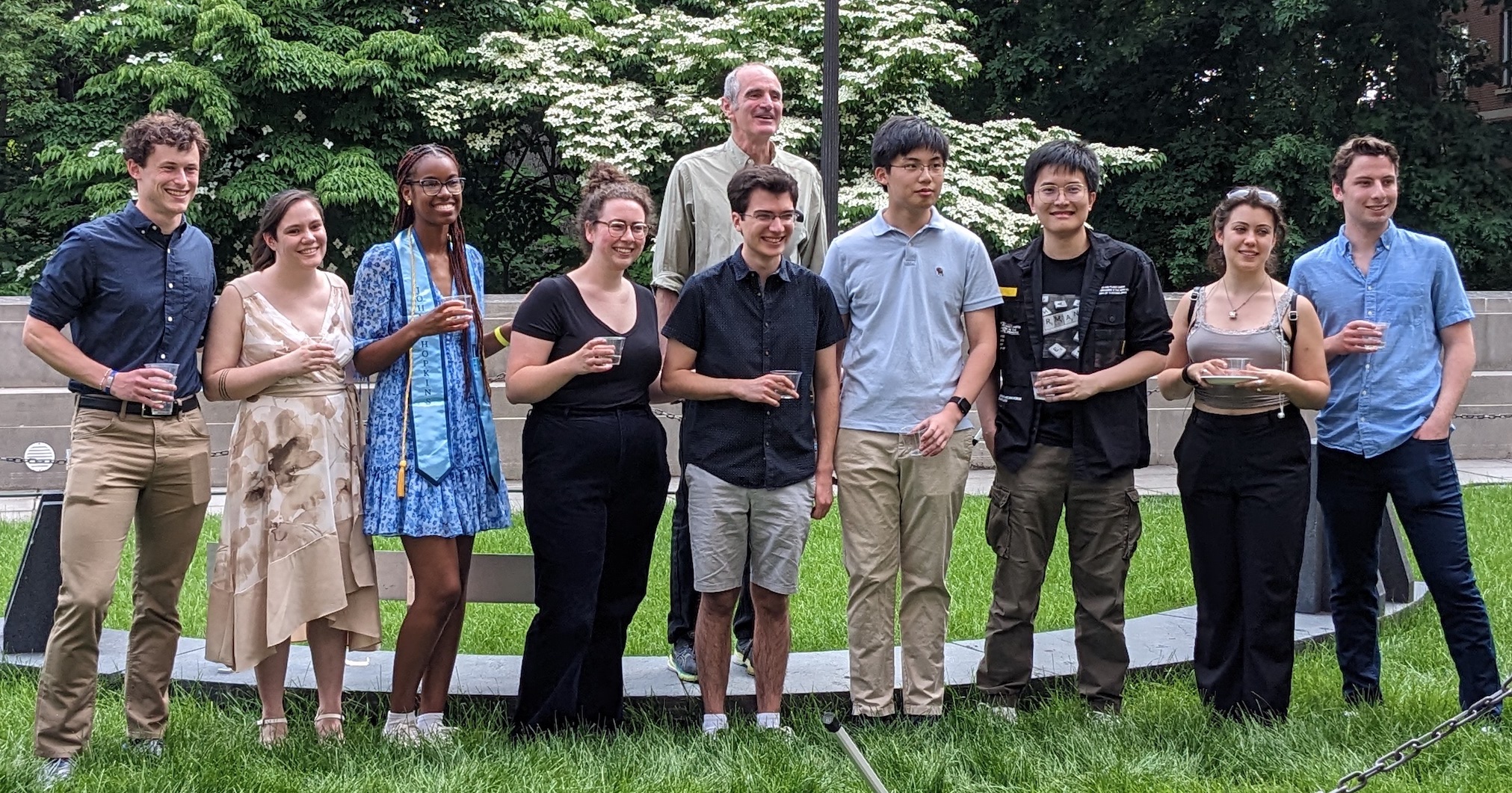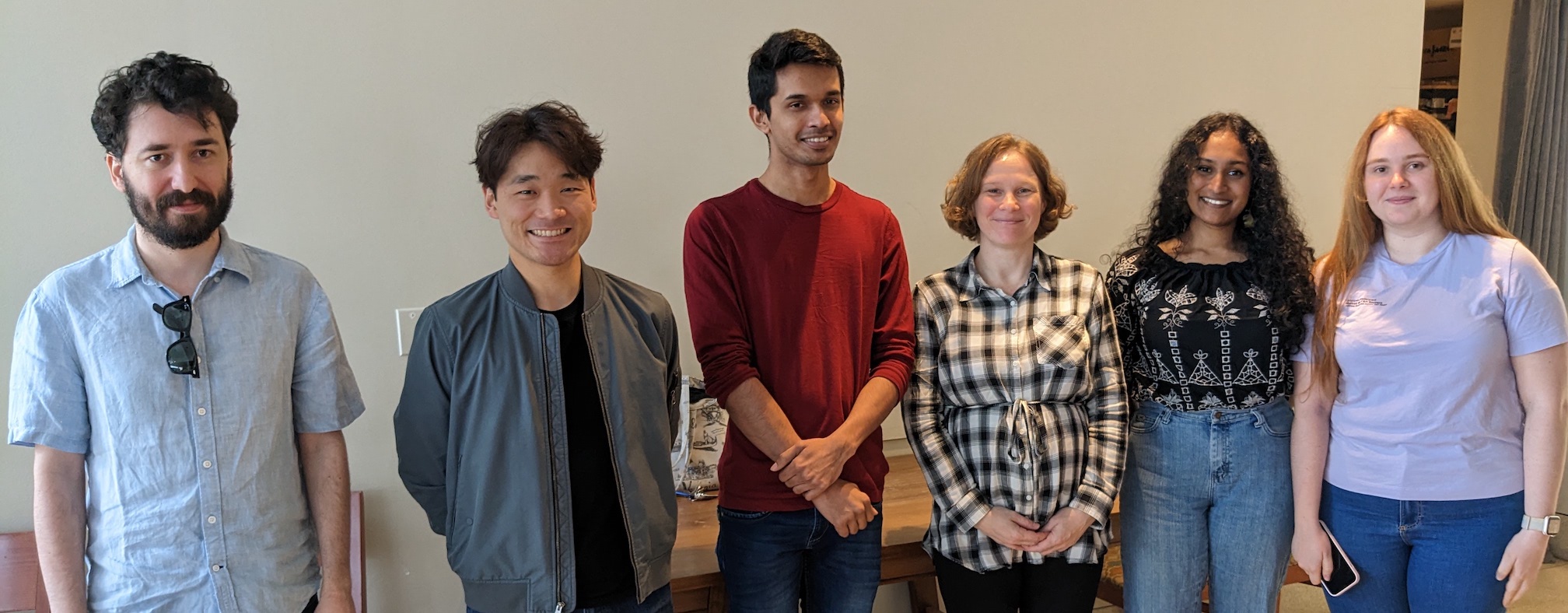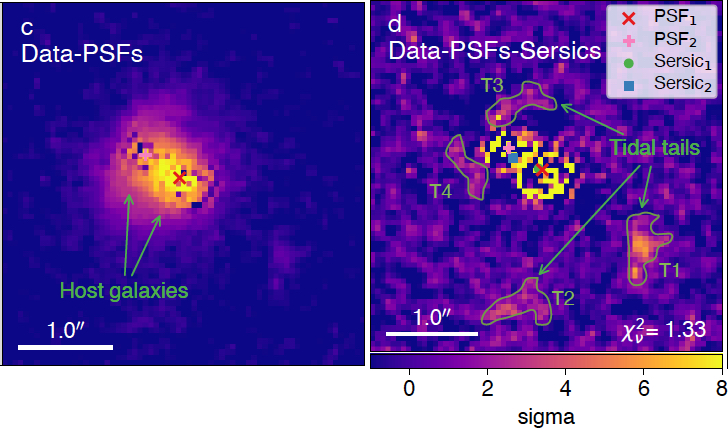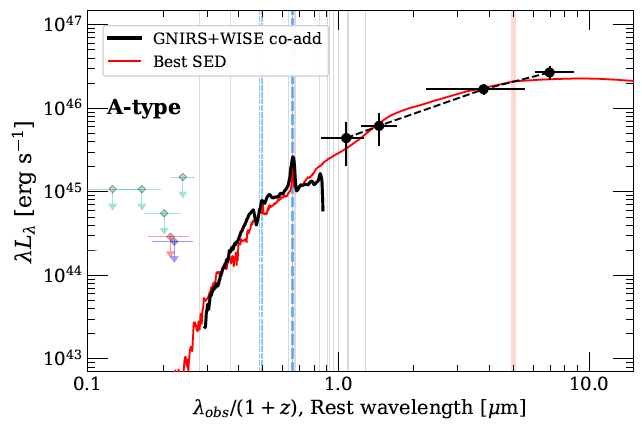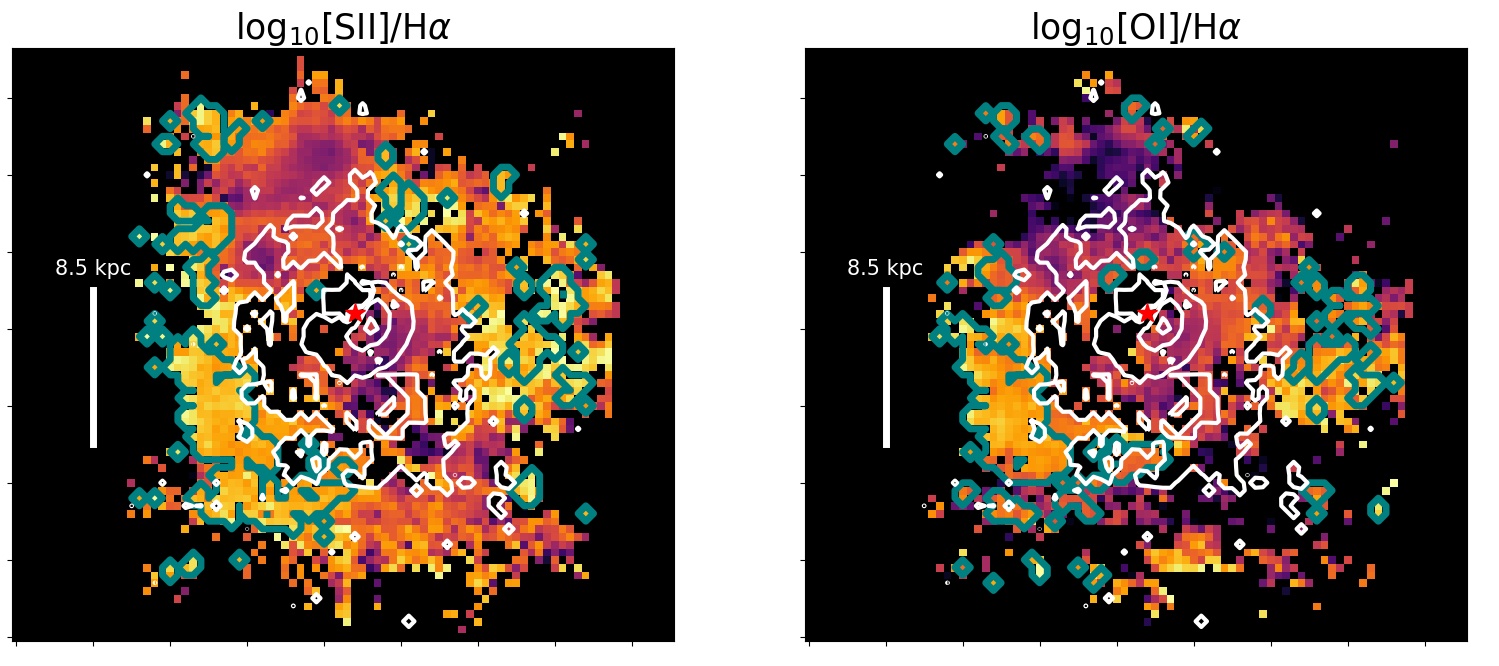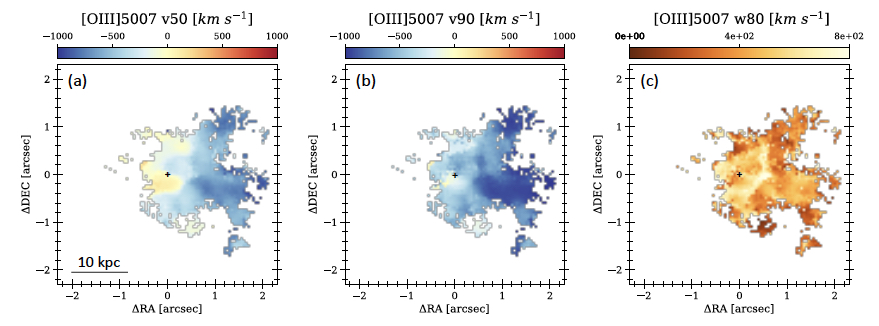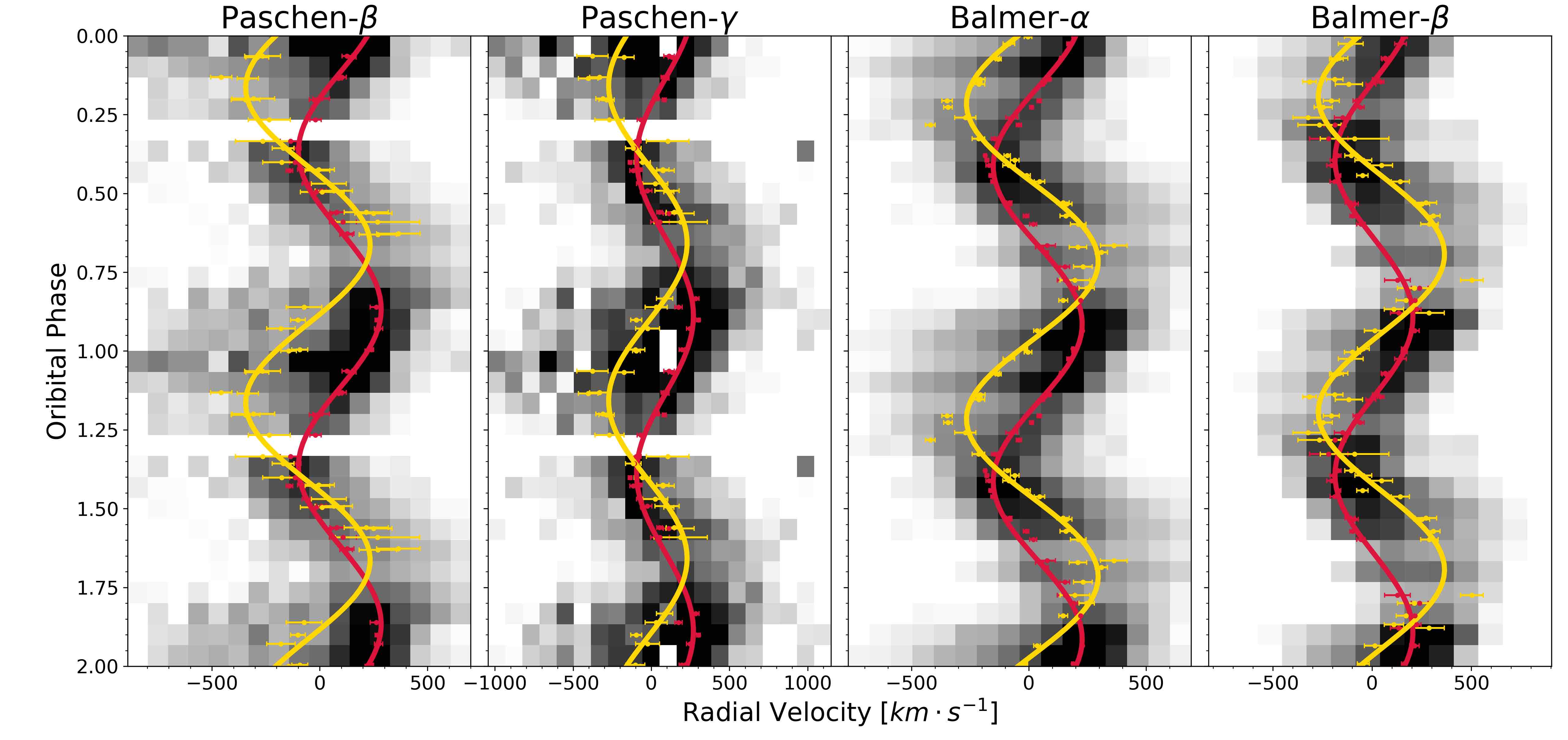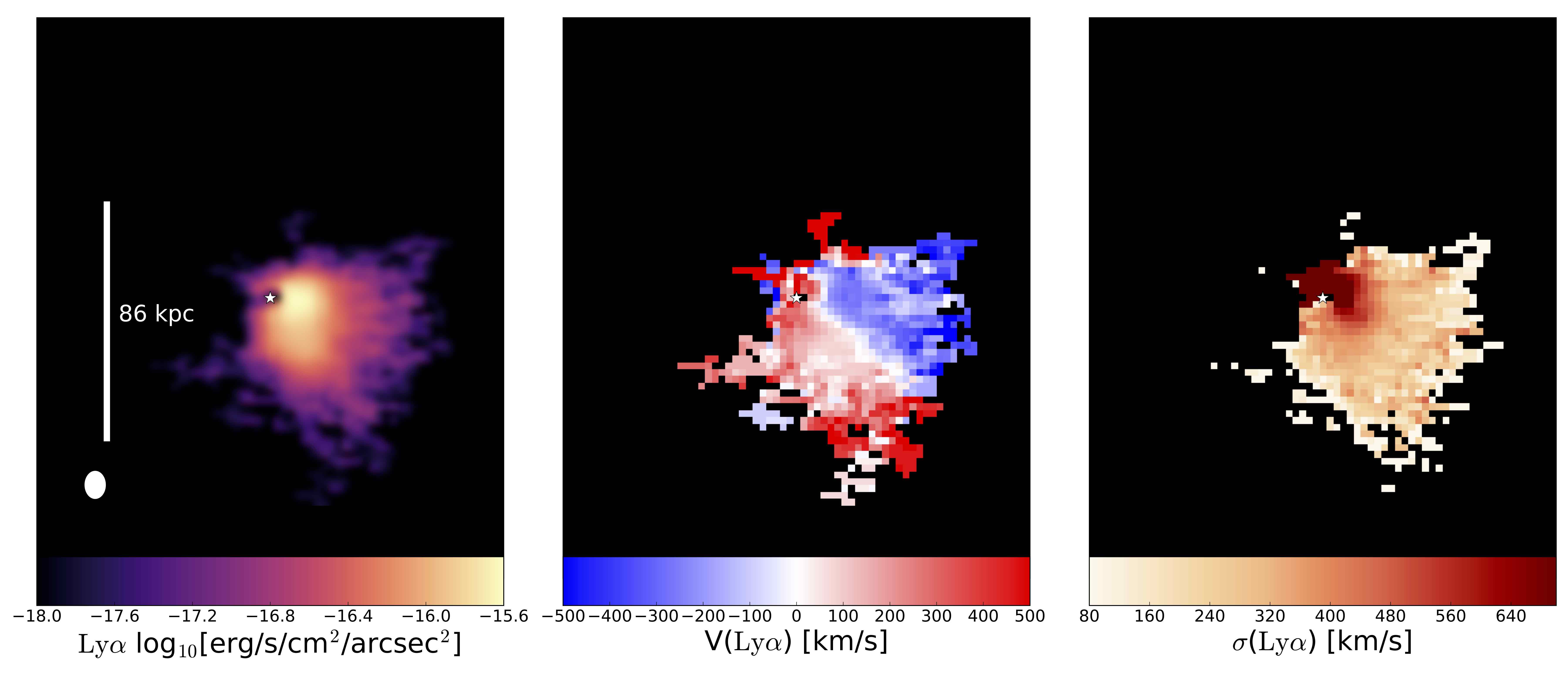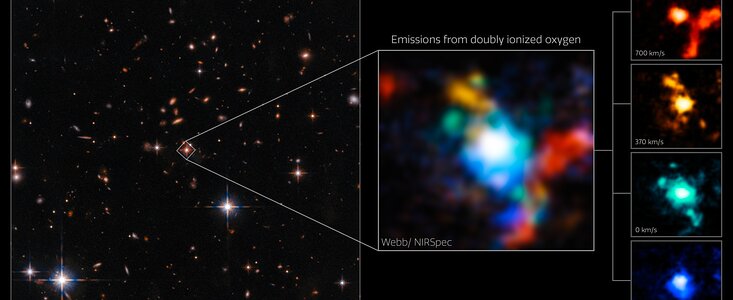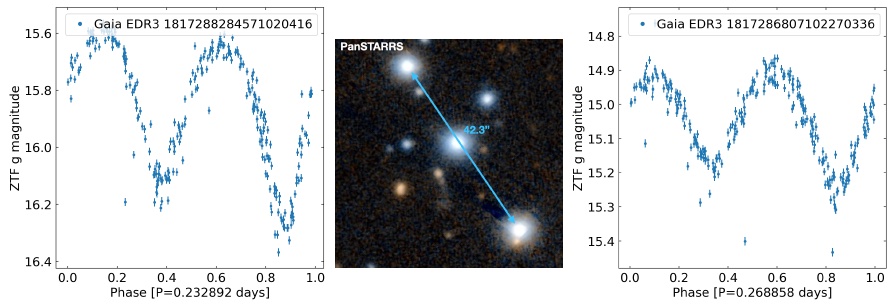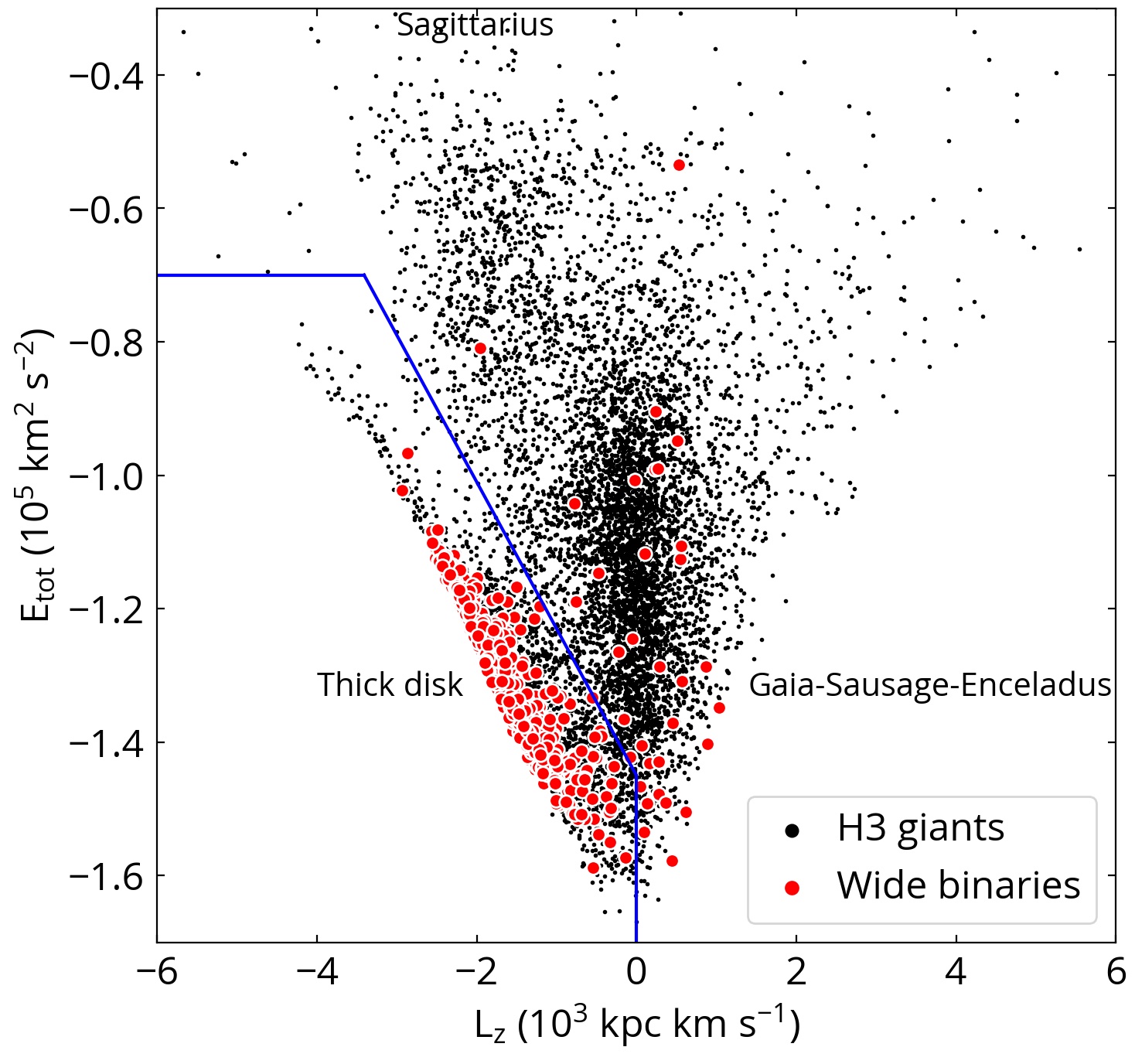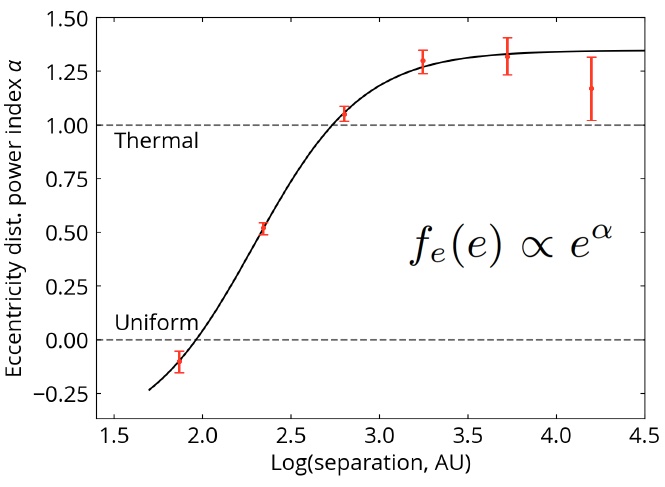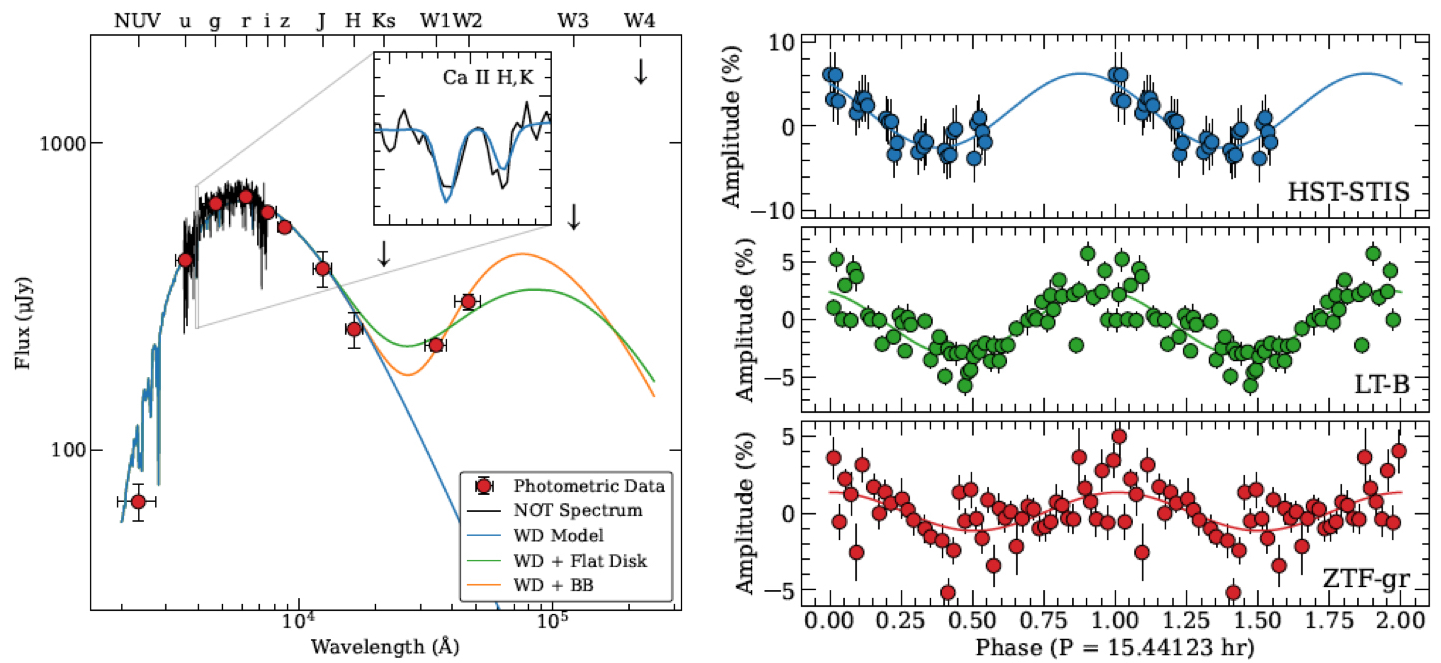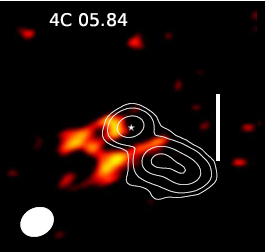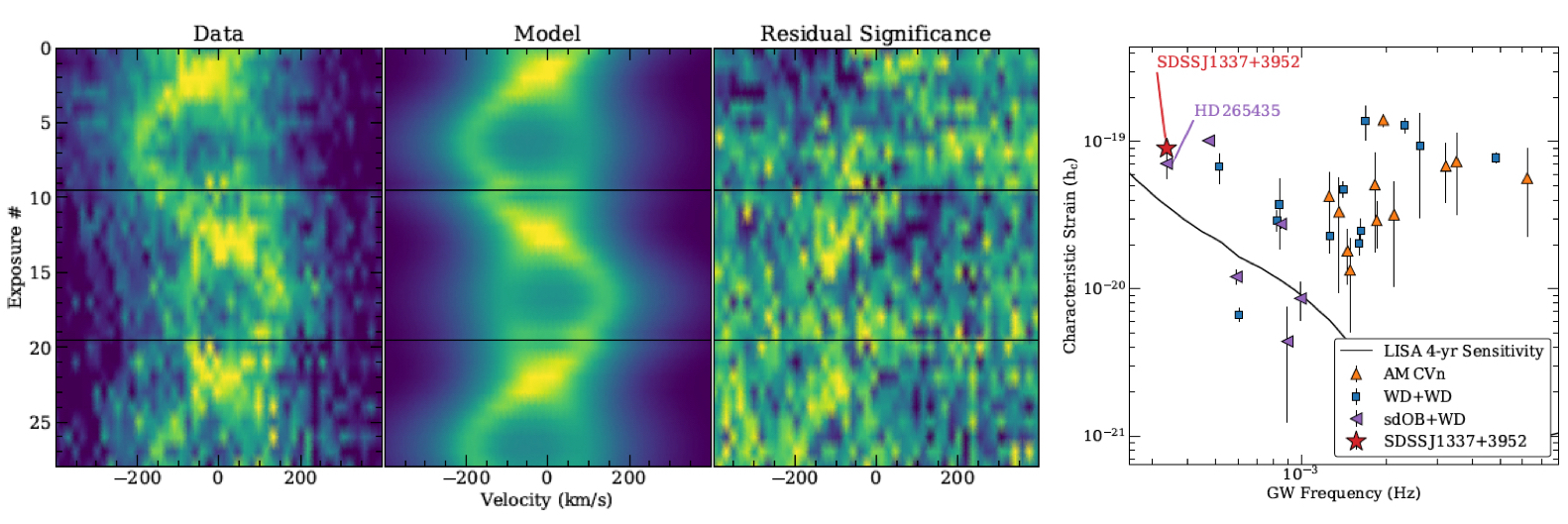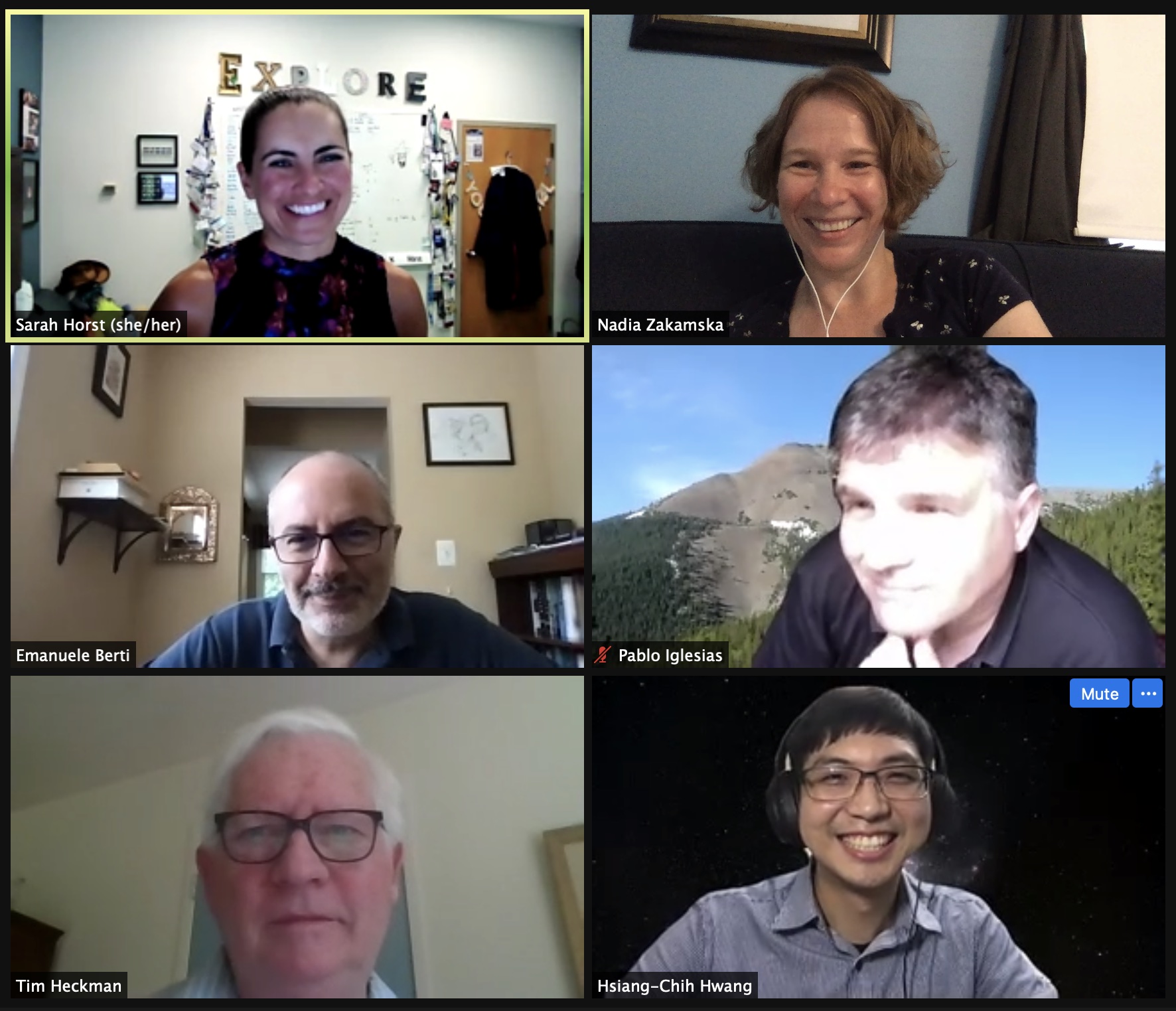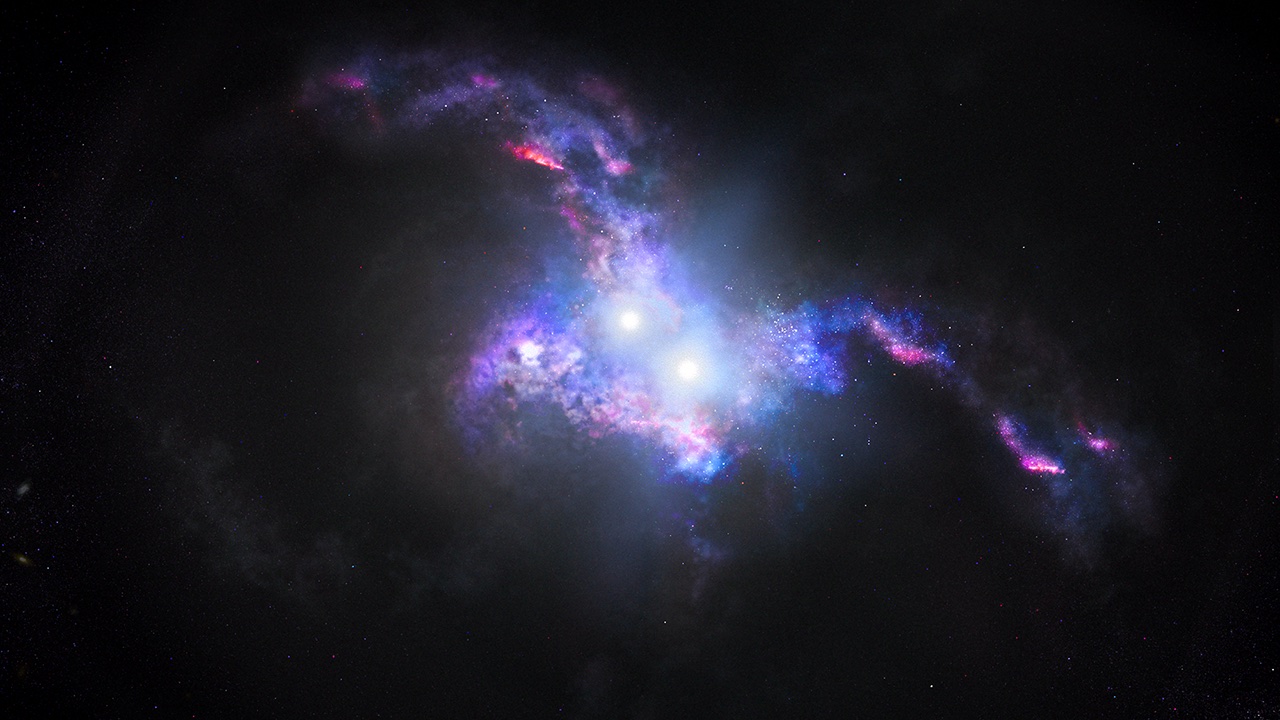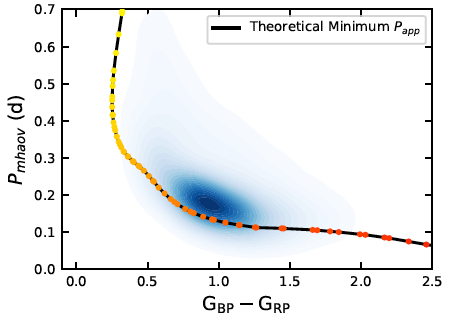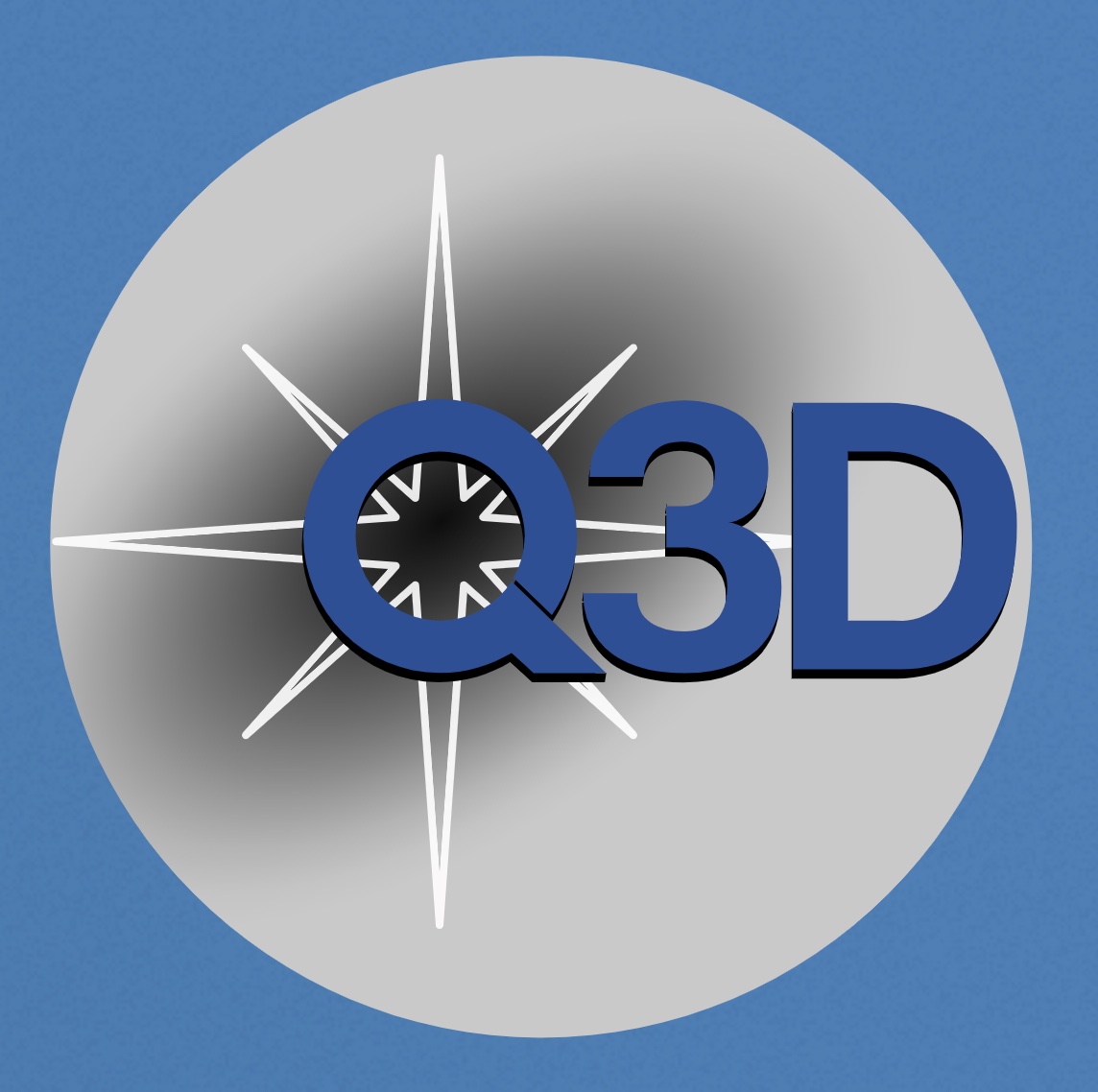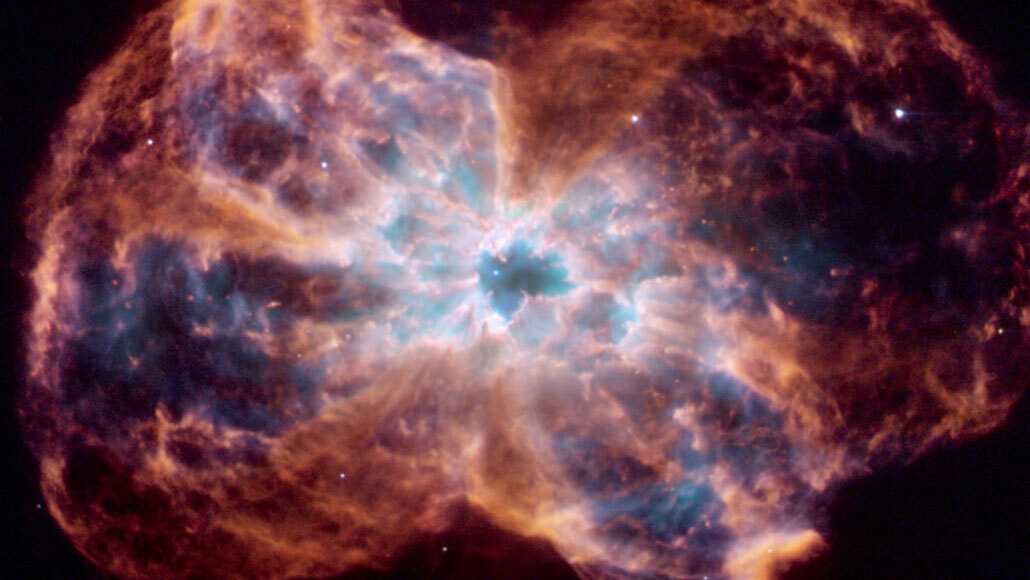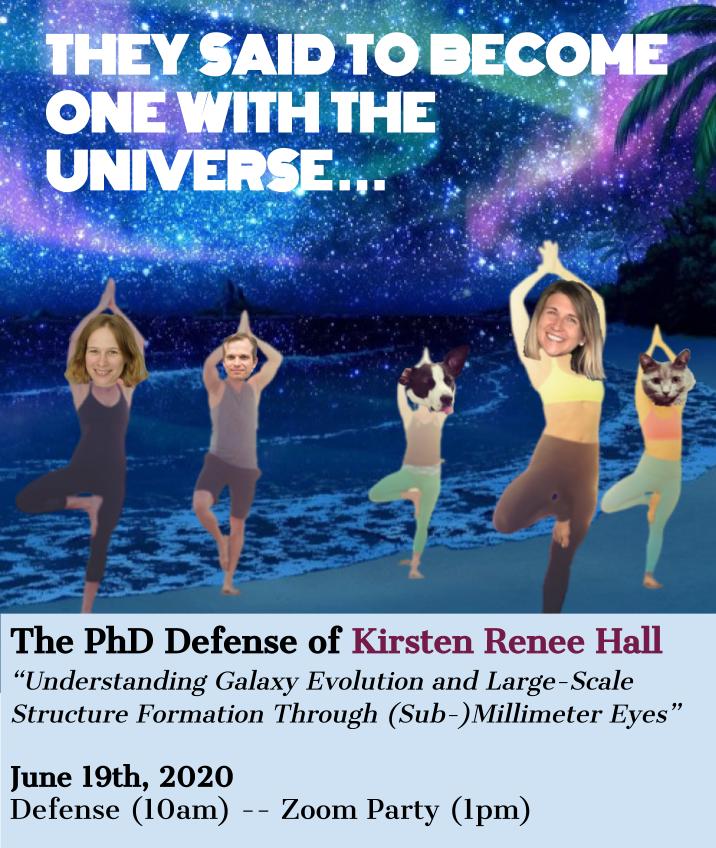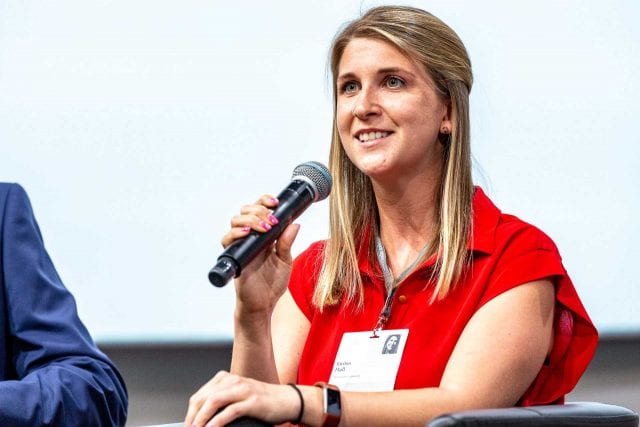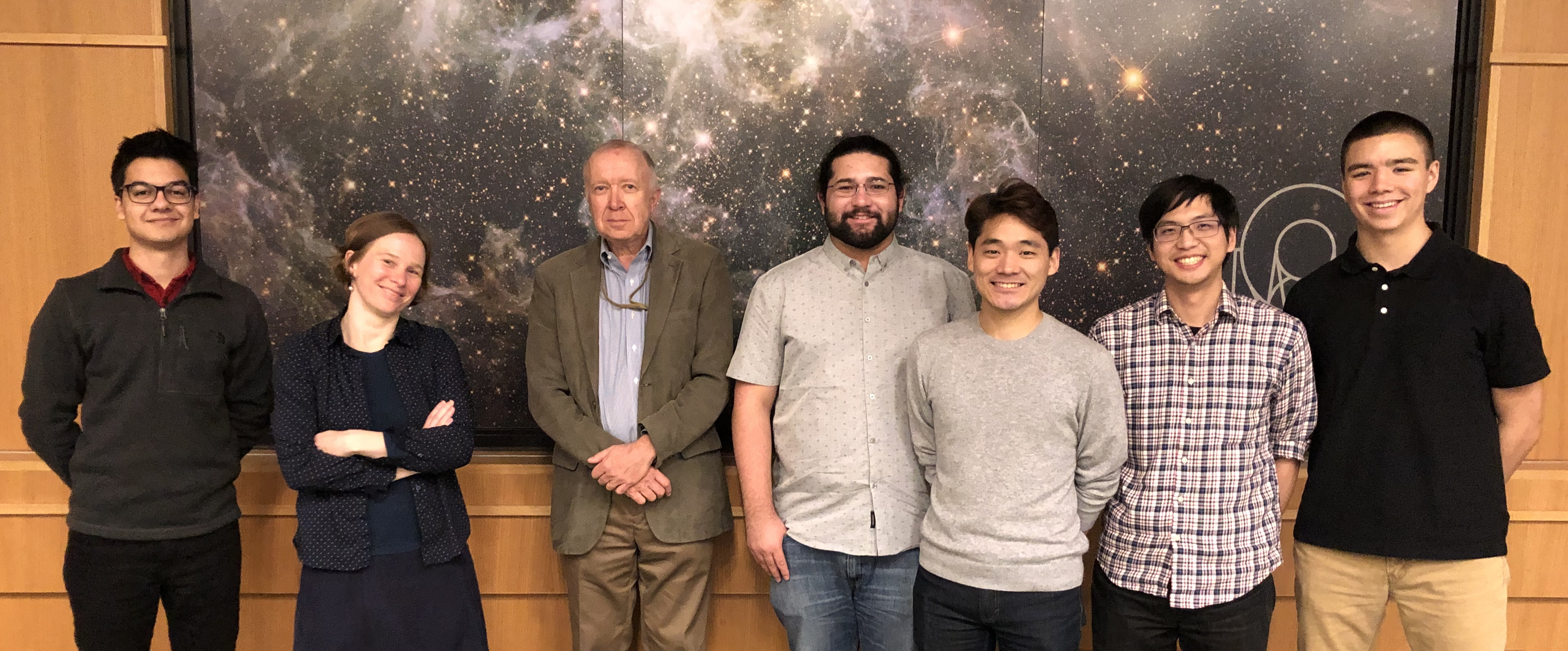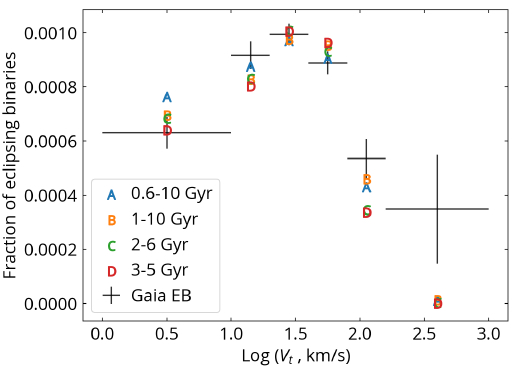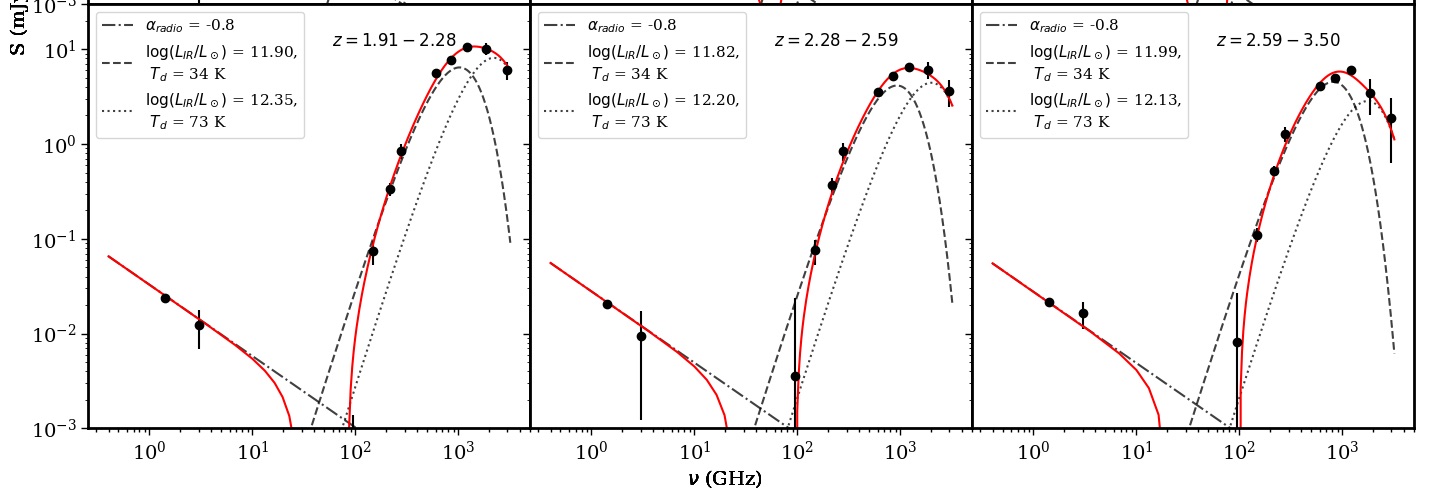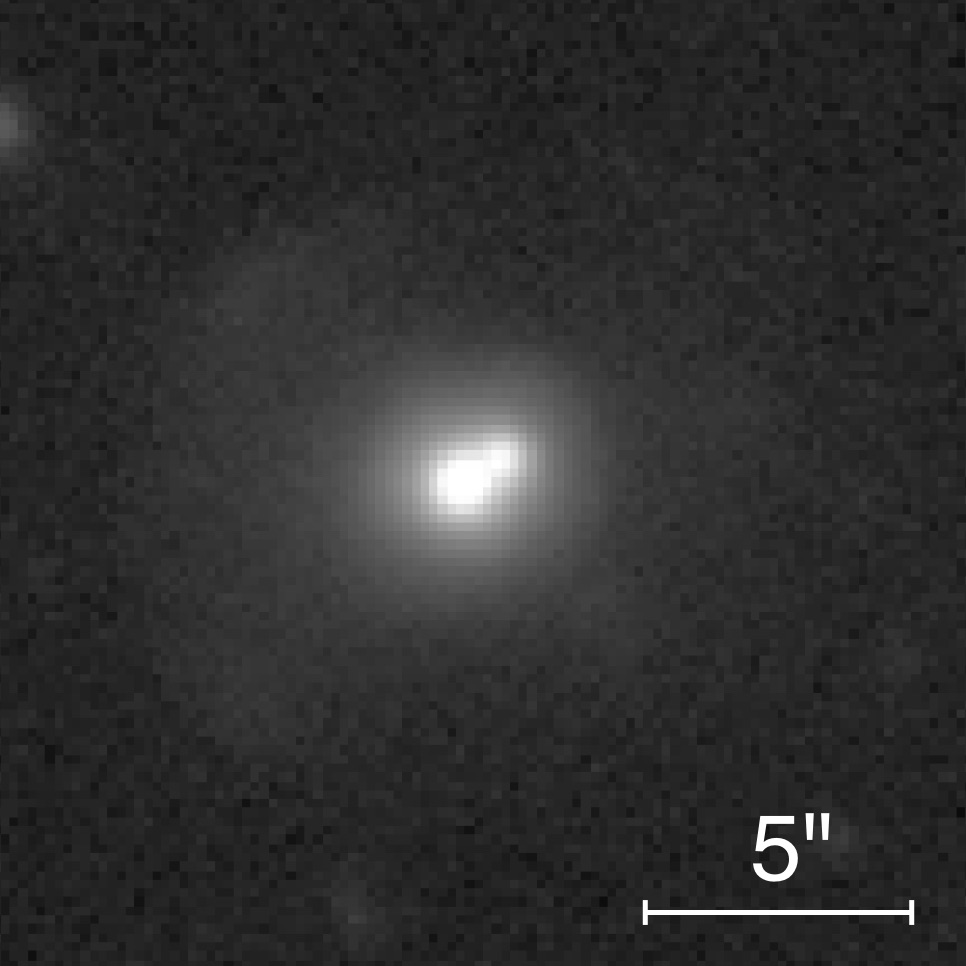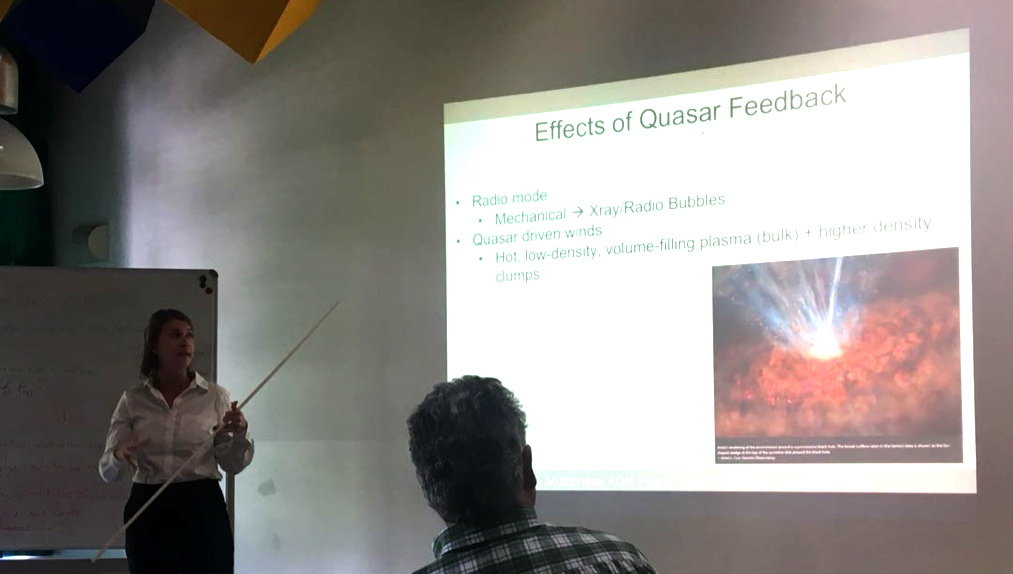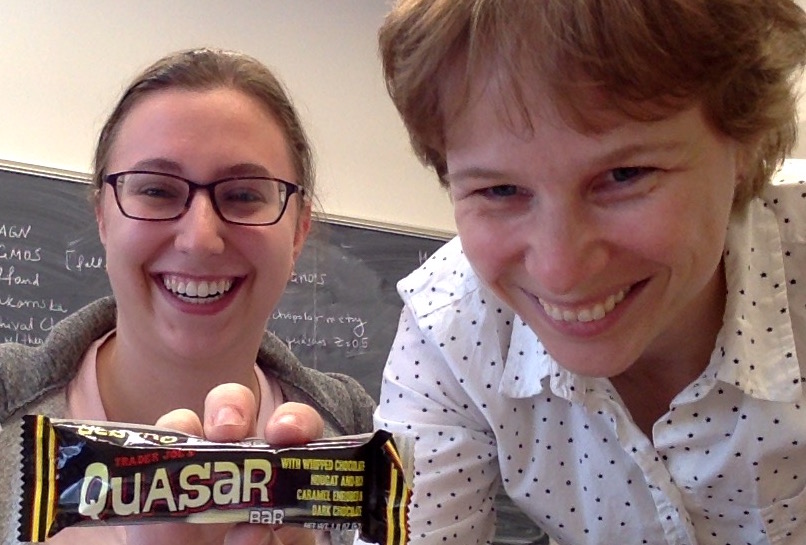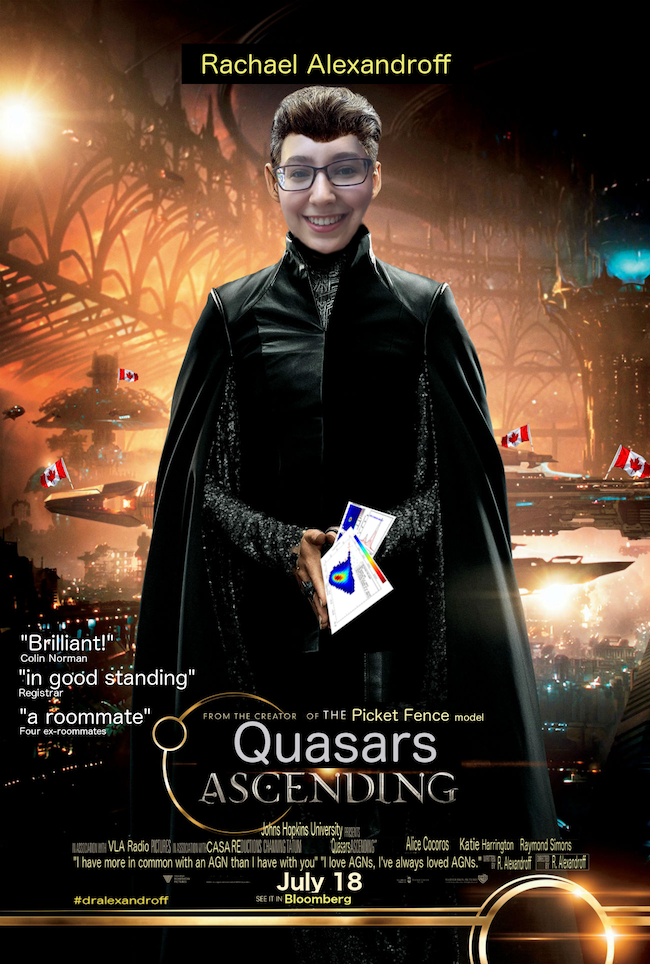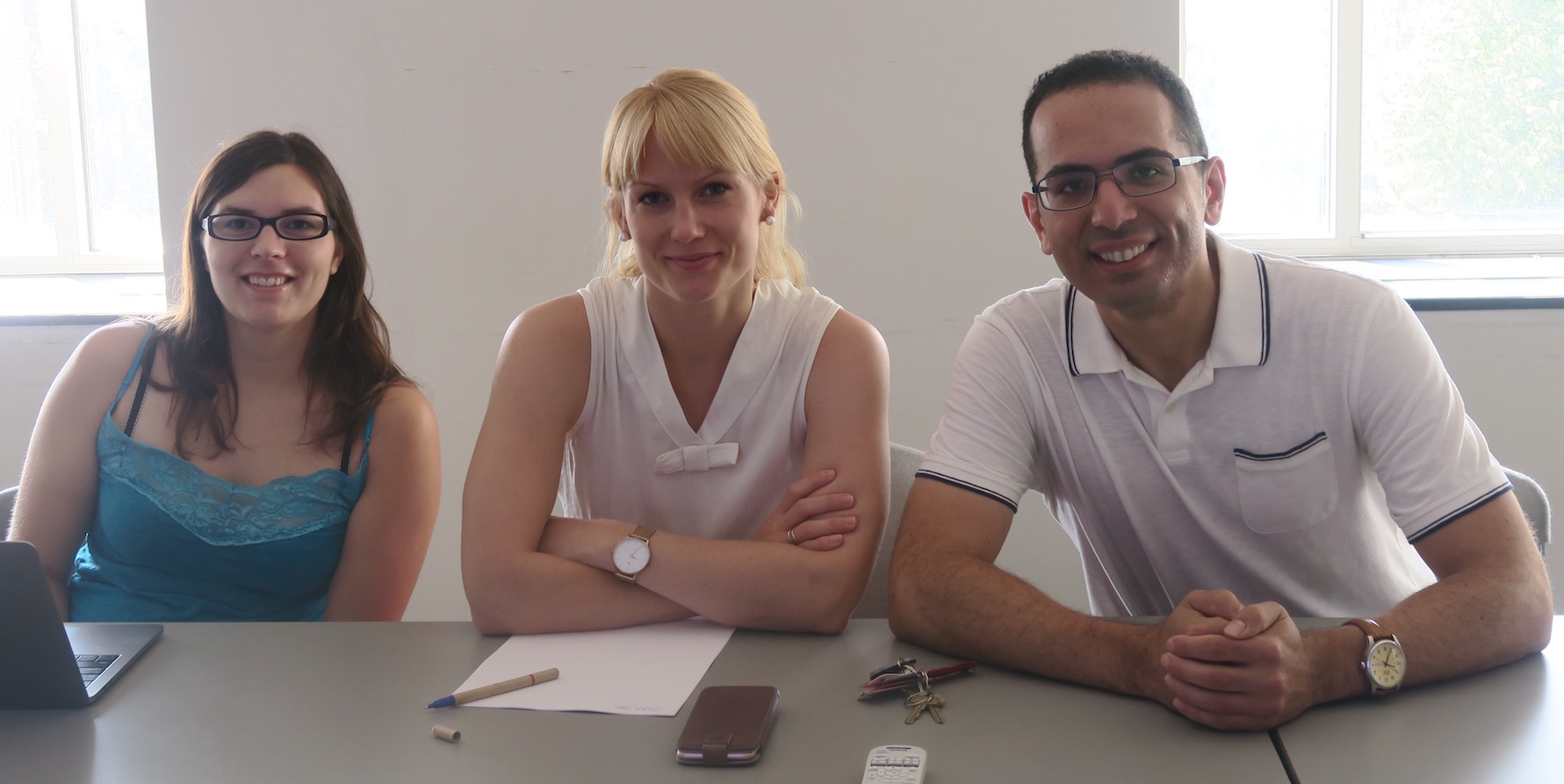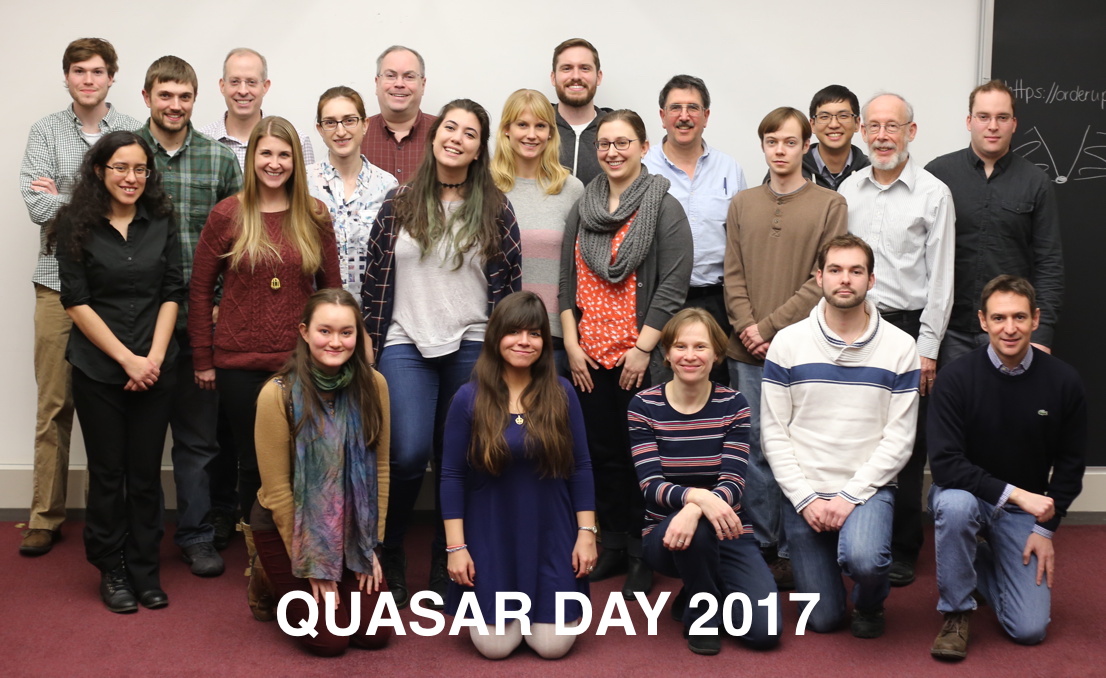| cover main news cv research data public teaching ENJL | ||||||||||||||||||||||||||||||||||||||||||||||||||||||||||||||||||||||||||||||||||||||||||||||||||||||||||||||||||
|
Latest news in our group
A rare binary of white dwarfs consisting of a hydrogen-atmosphere and a carbon-atmosphere white dwarfs was discovered by a graduate student in our group Gautham Adamane Pallathadka! This is only the fourth such object known, revealing a rare sub-channel of common envelope evolution. The full paper is here. [Image credit: Gautham Adamane Pallathadka. Left panel: phase-folded radial velocity variations for each object in the binary. Middle and right panels: the spectra and the spectral fits of the carbon and hydrogent lines.]
Our close collaborators in Brazil led by Prof. Rogemar Riffel have published a series of exciting papers on the outflows of molecular gas in three nearby active galactic nuclei observed by the James Webb Telescope. The full series of papers are: paper 1, paper 2, paper 3, and paper 4. Paper 4 presents a mind-boggling serendipitous discovery of a mini-strong lens. A nearby edge-on disk galaxy turned out to have been hiding a cosmic noon star-forming galaxy stretched into its Einstein ring behind the nearby galaxy's bulge. The discovery was only possible because of the integral-field unit capability of the James Webb Space Telescope which allowed careful subtraction of the nearby galaxy's light to reveal emission lines at a completely different redshift. Such objects may be hiding in plain sight and waiting to be revealed in large numbers. [Image credit: Left: image from the PanSTARRs survey with the approximate JWST field of view. Right: spectral decomposition and image reconstruction on by Rogemar Riffel.]
Potential discovery of a circumplanetary disk that occults its host star for 8.5 months every 44 years! Amazing high-resolution spectroscopy from GHOST / Gemini reveals absorption and emission lines in the occulting material hinting at never-before-seen dynamics of such disk. Complete paper available here. [Image credit: Nadia Zakamska. Left: photometric follow-up of the 2024-25 dimming event of ASASSN-24fw with different networks. Right: discovery of the kinematic substructure of the sodium absorption line indicating that the gas within the occulter is moving with characteristic velocities of 20-30 km/sec.]
Host galaxies of some of the most powerful quasars in the Universe revealed by James Webb observations in the paper by Tony Yu-Ching Chen. Quasars -- actively accreting supermassive black holes in centers of galaxies -- typically outshine their host galaxies, making it very difficult to study the cosmic co-evolution of black holes and their hosts. The problem is even worse in super-Eddington quasars, which are the most luminous quasars in the universe. In this paper we take the integral field unit data from James Webb to its limit to reveal the host galaxies of powerful quasars at cosmic noon, the peak epoch of quasar and star formation activity ripe with phenomena not seen in present-day universe. One fascinating finding is that the black holes are commonly offset from the center of their host, hinting that these quasars are merger remnants or maybe even black holes still settling into the centers of their hosts after a most-merger recoil. [Image credit: Yu-Ching Chen. From left to right: quasar-subtracted image of the host galaxy of an extremely red quasars, the best-fitting Sersic model, and the residuals after subtracting the best model. Green star marks the location of the quasar.]
Nicole Crumpler, a graduate student in our group, receives (ARCS) Foundation’s Scholar Award for the 2025-2026 academic year! Nicole has previously received the National Science Foundation Fellowship to enable her graduate research. Many congratulations, Nicole!!
Nicole Crumpler, a Ph.D. student in our group, makes the first direct detection of the temperature dependence of the white dwarf equation of state. This finding was a subject of a fun popular science article. White dwarfs are supposed to be some of the `simplest' stars, supported against the collapse due to their own gravity only by the electron degeneracy pressure, a quantum-mechanical effect on macroscopic scales. So in principle all white dwarfs of a given mass should have the same radius. But it was long known from theoretical work that there should be subtle deviations from this one-to-one relationship depending on the temperature of the star. The question was whether modern observations were precise enough to tease out and isolate the impact of the temperature on the radius at a few per cent level, and Nicole's approach is the first statistically significant measurement of this effect. [Image credit: Nicole Crumpler. Data (error bars) and models (solid lines) for white dwarf of different radii and surface gravitites. Warmer white dwarfs are more massive and have larger spectroscopic gravities at a given radius as expected from the theory.]
Swetha Sankar presents the discovery of Fe II emission produced when the winds driven a powerful quasar interact with and shock the interstellar medium of the host galaxy. Given the location of the shocked clouds, it is quite possible that we are witnessing the "back pressure" of the quasar-driven wind on the host galaxy, an effect predicted by numerical simulations of galaxy formation, but not yet observed in action. [Image credit: Swetha Sankar. Left: the spatial distribution of the Fe II emission with three clumps showing different ionization conditions. Right: comparison between the measured emission line ratios and theoretical models. At least one cloud cannot be explained by quasar photo-ionization and has to have a major contribution from shocks.]
Many congratulations to Dr. Yuzo Ishikawa who successfully defended his thesis on dual quasars today! Yuzo is headed for a postdoctoral position at MIT.
We went out to Ms. Shirley's restaurant to celebrate two new exciting job placements in our group! (Why didn't anybody remind me to take a picture??) Yuzo Ishikawa, a finishing PhD student, will be headed for a postdoctoral position at MIT to study extremely high redshift universe. Stefan Arseneau, a graduating senior, will be going to Boston University for a PhD program in Astrophysics. Many congratulations!!
New results from our James Webb Space Telescope program on dual quasars! Yu-Ching Tony Chen, a postdoc in our group, analyzes mid-infrared integral field unit data and uses mid-infrared star formation diagnostics like the Polycyclic Aromatic Hydrocarbons and the [FeII] emission line to discover that the host galaxy of one of the dual quasars discovered by our group is extremely star-forming, making new stars at a rate of 1000 solar masses per year. Not only is this object comparable to the most starbursting galaxies in the universe, but it presents a puzzle when its molecular gas supply is found to fall far short of the expectations based on its extremely high star formation rate. [Image by Y.-C. Chen: the intensity (left) and the line-of-sight velocity (middle) maps of [FeII] line at 5.3 micron, most likely produced in shocks from supernova explosions and therefore tracing star formation. The galaxy is producing stars with enormous efficiency, with its star formation rate well surpassing that expected based on its molecular gas supply (right).
Yuzo Ishikawa, a 5th year graduate student in our group, analyzed near-infrared James Webb data for the same object to discover a massive galaxy in regular rotation. This is somewhat unexpected as dual quasars are expected t be primarily due to recent major mergers. [Image by Y. Ishikawa: the intensity, the velocity dispersion and the line-of-sight velocity of hydrogen gas in the host galaxy of dual quasars SDSSJ0749. The blue / red pattern in the figure on the right is a classical signature of a rotating galactic disk inclined with respect to the plane of the sky.]
Two exciting papers from our close collaborators on Extremely Red Quasars, a fascinating population of near- or super-Eddington quasars at cosmic noon. Not only are those objects among those with the highest accretion rates and luminosities in the universe. But they are known to host unprecedenent extremely fast outflows of ionized gas on galactic scales, with [OIII]5007 velocities reaching 6000 km/sec, defying standard "Broad Line Region / Narrow Line Region" classification metrics. These objects provide an important and possibly unique texting grounds for theories of super-Eddington accretion. Yilun Ma, a graduate student in Princeton, demonstrates that Extremely Red Quasars are not only extremely obscured and are the long-sought examples of the high-redshift Compton thick quasar population. But they are also intrinsically X-ray weak, especially those of them with fastest ionized gas outflows. This work may be direct evidence for the theoretical paradigm in which weak X-rays are necessary in order to facilitate line-driven winds. [Image by Y. Ma: the summary of X-ray properties of Extremely Red Quasars and their sister population Hot Dust Obscured Galaxies. The solid and dashed lines show the locus of infrared and X-ray luminosities of extremely powerful unobscured quasars for comparison.]
Marie Wingyee Lau, a researcher at UC Riverside, uses integral field spectroscopy from the ground to demonstrate that the extremely fast winds in Extremely Red Quasars are relatively compact, on scales of 1 kpc. This suggests that Extremely Red Quasars may be a relatively young population where quasar feedback is in the early stage of the process of clearing gas out of the host galaxy. [Image by M. Lau: the compact continuum, the compact but spatially resolved [OIII] nebula, and the [OIII]+Hbeta blend in an extremely red quasars SDSSJ2223. The extremely large spread of [OIII] velocities in these objects is unsurpassed by any other quasar population.]
Yuzo Ishikawa, a 5th year graduate student in our group, winds the Rodger Doxsey Travel Award for the AAS 243rd meeting! Yuzo is one of only 10 winners, amongst all dissertation presentation submissions.
Two new papers from our Galactic Astronomy contingent: The discovery by graduate student Gautham Adamane Pallathadka of an intriguing binary system containing a rapidly evolving and tidally distorted puffed-up extremely low-mass (ELM) white dwarf and an unseen significantly more massive companion -- a nearly Chandrasekhar mass white dwarf or a neutron star. [Image by G. Adamane Pallathadka: a high-precision photometric and spectroscopic fit of the data for the pre-ELM white dwarf. Our group specializes in high-quality atmospheric models for evolved stars.]
A unique measurement of the white dwarf equation of state using gravitational redshifts from their surfaces by undergraduate student Stefan Arseneau. He assembled the largest available sample of white dwarfs in wide binaries, where the Galactic motion relative to the observer can be inferred from the measurements of the main sequence companion and corrected for. [Image by S. Arseneau: the color-magnitude diagram of white dwarfs paired up with their wide-binary main sequence companions (left) and the tentative 2-sigma detection of the temperature dependence of the equation of state of white dwarfs in this sample, compared to theoretical models.]
More exciting results from our JWST Early Release Science program Q3D! The clearest view of an extremely powerful galactic outflow produced by a quasar at `cosmic noon' as presented by JHU postdoc Andrey Vayner. [Image by A. Vayner: the JWST color composite map of the ionized gas in an extremely red quasar at z=3 J1652, with different colors corresponding to different emission lines, with an overlay of the map of the outflowing gas.]
More exciting results from our JWST Early Release Science program Q3D! The program's software lead Dr. David Rupke demonstrates the use of mid-infrared emission-line diagnostics in studies of quasar winds. This paper was featured in the American Astronomical Society Newsletter: AAS Nova Article [Image by D. Rupke: the JWST kinematic maps of the ionized gas in a red quasar which produces powerful galactic outflows, in a standard optical diagnostic line [OIII] and in a mid-infrared line [SIV] that can only be probed with JWST data]
Torus skin outflow in a near-Eddington quasar revealed by spectropolarimetry: a theory paper by Nadia Zakamska explains a puzzling spectropolarimetry observation in several extremely red quasars. The new model allows us to constrain the geometry of quasar obscuration and outflows on an unprecedented small scale which cannot yet be probed by any other observations. The model is available as a Jupyter Notebook on Github. [Image by N. Zakamska: the polarization position angle undergoes dramatic changes across emission lines in an extremely red quasar SDSSJ1652. The new model of axisymmetric outflows scattering incident unpolarized radiation can quantitatively explain this pattern and use it to constrain the geometry of the circumnuclear gas.]
Academic family reunion at Strauss - Lupton Fest: Michael Strauss and his students, including NLZ (and one student of a student!), his advisor Marc Davis and some of his students, and his advisor Jim Peebles (Nobel Prize in Physics in 2019). Five academic generations are represented in the first photo! [Images by X. Fan]
Many congratulations to the JHU Undergraduate Class of 2023! Four graduating physics seniors were members of our research group: Kyle Schneider (first from right), Yiqi Andrew Liu (third from right), Mansha Kapur and Eric Ding, and several other seniors from other majors as well: John Magardino, Matthew Kleiman, Brandon Stride. And additional congratulations to Yiqi Andrew Liu who receives the Department's Kerr award and is headed to Princeton for graduate school in the Fall! [Image: May 2023 reception in honor of physics seniors with Dpt. Chair Prof. Leheny in the back.]
Stefan Arseneau, an undergraduate student in our group, receives the Provost's Undergraduate Research Award to complete his work on the white dwarf equation of state as measured in wide binaries. Congratulations!
Group celebration at ``Gertrude's" in Baltimore Museum of Art! We have celebrated our successful release of our group's JWST software (q3dfit), several new JWST papers and especially Andrey Vayner's award of the NASA postdoctoral fellowship!
Another beautiful paper led by our collaborators at the University of Illinois on our joint project to discover and characterize dual quasars at cosmic noon: Nature paper on confirming a high-redshift dual quasar and the associated Hubble press release [Image: subtraction of the two quasars from the HST image reveals the host galaxy and the faint tidal tails. Image credit: Y.-C. Chen et al. 2023]
A new paper on confirming a population of obscured, high-redshift, high-luminosity active nuclei Infrared spectroscopic confirmation of z=2 photometrically-selected obscured quasars by Yuzo Ishikawa [Image: spectral energy distribution of one of the confirmed objects. Image credit: Yuzo Ishikawa]
New papers by our group and our close collaborators working on the James Webb Space Telescope Early Release Science program ``Imaging spectroscopy of quasar hosts with the JWST" (PI: Dominika Wylezalek, CoPIs: Nadia Zakamska, Sylvain Veilleux, Software lead: David Rupke)! In the paper ``First results from the JWST Early Release Science Program Q3D: Ionization cone, clumpy star formation and shocks in a z=3 extremely red quasar host", by Vayner et al. 2023 we present a study of gas kinematics and ionization conditions and discover powerful shocks propagating through the interstellar medium of a quasar host galaxy. [Image: maps of shock diagnostic line ratios in the host galaxy of an extremely powerful red quasar SDSS J1652. Obtained using JWST NIRSpec instrument. Image credit: Andrey Vayner]
In the paper ``First results from the JWST Early Release Science Program Q3D: The Warm Ionized Gas Outflow in z=1.6 Quasar XID 2028 and its Impact on the Host Galaxy", by Veilleux et al. 2023 we present kinematic line mapping of the [OIII] emission in a high-redshift quasar obtained by the software developed in our group and showing signatures of powerful quasar-driven winds. [Image: median velocity, blue-shifted velocity and velocity width maps of XIS 2023. Obtained using JWST NIRSpec instrument. Image credit: Sylvain Veilleux and Weizhe Liu]
Nadia Zakamska is one of the three University-wide finalists for the President's Frontier Award. University announcement
New papers in our group! Multi-wavelength analysis of a magnetic cataclysmic variable by Yiqi Andrew Liu et al. ``CSS1603+19: a low-mass polar near the cataclysmic variable period minimum''. We use optical and infrared data to derive an orbital and dynamical solution and discuss the nature of the unusually eclipsing infrared excess in this object. [Image credit: Yiqi Liu]
Cold-mode gas accretion on two galaxy groups at z=2 by Vayner et al., based on integral-field unit data from the Keck Cosmic Web Imager. Cold-mode accretion is a long-sought phenomenon important in the build-up of high-redshift galaxies, but which can only now be discovered directly thanks to new observational capabalitiies and illumination of the circum-galactic medium by the quasar. [Image credit: Andrey Vayner]
Our group's first JWST paper -- ``First results from the JWST Early Release Science Program Q3D: Turbulent times in the life of a z=3 extremely red quasar revealed by NIRSpec IFU''. Here we discover a very high density of galaxies moving at very high velocities relative to the host galaxy of an extremely rapidly accreting high-redshift quasar. This work is covered for general public in the ESA / NASA press release, JHU HUB article and in other venues. [Image Credit: ESA/Webb, NASA & CSA, D. Wylezalek, A. Vayner & the Q3D Team, N. Zakamska]
Our group's plans for JWST in this interview to the Institute for Advanced Study
An exciting new paper on the enhancement of hierarchical quadruple stellar systems. [Figure, left and right: light curves showing the eclipsing binary nature of the components of the wide binary; middle: position of the objects on the sky. The 2+2 binary is confirmed to be a physical quadruple system through the common proper motions and radial velocities of the components. Figure credit: Gavin Fezenko]
JWST has successfully launched! Our group is looking forward to JWST data from an Early Release Science Program and four Cycle 1 programs in extragalactic astrophysics as early as Summer 2022. Our group is developing state-of-the-art quasar/host decomposition software which will allow high-quality analysis of JWST integral-field unit data.
Nadia Zakamska's Princeton / IAS colloquium "White dwarf astrophysics in the era of modern surveys"
Important new results in Galactic dynamics led by Hsiang-Chih Hwang who recently graduated from our group and is now a postdoctoral fellow at the Institute for Advanced study: The eccentricity distribution of wide binaries and their individual measurements -- we develop a new method to measure eccentricity distributions of stellar binaries without the need for expensive and time-consuming follow-up observations. Furthermore, we discover that wide binaries show two distinctly different eccentricity distributions -- and thus likely originate from two different formation mechanisms -- with lower eccentricities at separations smaller than 100 AU and higher eccentricities at separations larger than 1000 AU. Wide binaries from the H3 survey: the thick disk and halo have similar wide binary fractions. It is with some surprise that we find that at a fixed metallicity, the extremely old Galactic halo (likely accreted in ancient merger events) has the same wide binary fraction as the Galactic thick disk. This implies that metallicity, not star formation history or dynamics or larger galactic environment, must be the primary parameter controlling binary fraction. [Figure, left: newly discovered wide binaries in the energy-momentum space; right: the slope of the eccentricity distribution of Galactic wide binaries as a function of binary separation showing a dramatic transition in the dynamical properties of binaries between 100 and 1000 AU. Figure credit: Hsiang-Chih Hwang]
A new paper from our group on a candidate runaway donor remnant from a Type Ia Supernova explosion (Chandra et al. 2021). The target is a puffed-up, low-mass white dwarf moving with spatial velocity of 1000 km/sec. Here we further characterize this enigmatic object using follow-up infrared and optical observations and we discover a dusty disk through its time-varying infrared excess. We also measure the rotational period of the star from the optical variability. Both observations support the runaway Type Ia donor scenario. [Figure, left: the spectral energy distribution of the object showing a strong infrared excess likely due to a dusty disk; Figure, right: the optical light curves phase-folded at the best period of 15 hours, likely due to rotation. Image credit: V. Chandra]
A new paper on our group's discovery of strong, clumpy molecular outflows in high-redshift radio-loud quasars (Vayner et al. 2021). We used Atacama Large Millimeter/submillimeter Array (ALMA) to map the spatial and the kinematic distribution of CO rotational lines and found that the power of molecular outflows is 0.1-1% of the bolometric luminosity of the quasar. This implies that the quasars are potentially exerting strong feedback on their host galaxies. One surprise of the study is that molecular outflows are often very lumpy, with `bullets' of molecular gas detected several tens of kpc away from the quasar, moving with hundreds of km/sec. [Figure: the spatial distribution of molecular gas (orange) compared to the spatial distribution of the synchrotron emission from the jet (white contours). A 1 arcsec (about 8 kpc) scale bar and the beam size of the observations are also shown. Image credit: A. Vayner]
IAS Welcomes 271 Scholars for 2021–22 Academic Year
Our group's discovery of a 99-min white-dwarf / white-dwarf binary in the early data from the fifth generation of the Sloan Digital Sky Survey (Chandra et al. 2021). This is the first scientific publication of SDSS-V! The initial candidate selection was made on the basis of the spectral variability of the target in the 15-min SDSS sub-exposures, and it was confirmed using observations from the Gemini telescope. [Figure, left: time-resolved spectra with yellow color showing absorption features; the best-fit model; and the residuals. Figure, right: the frequency and the strain of the graviational waves expected from our target and from other double-degenerate systems in the literature compared to the expected detection limit of the Laser Interferometer Space Antenna (LISA). Image credit: V. Chandra]
Many congratulations to Hsiang-Chih Hwang on his thesis defense! Hsiang-Chih is headed to the Institute for Advanced Study in Princeton with a postdoctoral fellowship.
Many congratulations to Vedant Chandra and Evan Petrosky who are heading, respectively, to Harvard and UMichigan for graduate programs!
Our Nature Astronomy paper on the discovery of a hidden population of high-redshift dual quasars has been the subject of several press releases. Here is the press release from the Hubble Space Telescope, here is one by the NOIRLab, and here is an article I wrote at a publicly accessible level about the discovery method and its significance. [Figure: artist's impression of a merging galaxy with dual active black holes. Image credit: NASA, ESA, Joseph Olmsted (STScI)]
Congratulations to group members Andrey Vayner, Yuzo Ishikawa, and Rogemar Riffel on their successful Cycle 1 JWST proposals!
A major technical accomplishment by Evan Petrosky et al.: "Variability, periodicity, and contact binaries in WISE" -- provides tools for analysis of massive and irregularly sampled variability surveys and discovers tens of thousands of eclipsing binaries in the WISE survey. [Figure: the apparent periods of eclipsing binaries discovered in our study, shown by the blue-shaded distribution as a function of stellar color, with low-mass, red stars on the right. The theoretical minimum limit at each color is shown with the solid line. Image credit: E. Petrosky, H.-C. Hwang]
New paper by Andrey Vayner et al.: "Powerful winds in high-redshift obscured and red quasars" on the discovery of galactic-scale winds associated with the tantalizing population of extremely red quasars which exhibit some of the highest-velocity extended outflows in the universe.
Happy end of a challenging semester to everybody! Public talk by Nadia Zakamska, Melissa Diamond and Yishu Wang
A new paper finding a non-monotonic, strong metallicity dependence of the binary fraction of stars in the Milky Way by Hsiang-Chih Hwang et al. Prof. Zakamska gave a department colloquium describing our group's efforts in stellar astrophysics; the recording is available here (or a direct link here)
Congratulations to Dominika Wylezalek, a former postdoc in our group, on becoming a Group Leader at the University of Heidelberg and on receiving Emmy Noether Research Fellowship!
Our approved Early Release Science program for JWST was featured on the NASA website! In this article our program is described in general science terms. The Principal Investigator is Dr. Dominika Wylezalek, formerly a postdoc in our group and now Group Leader at the University of Heidelberg. The Co-principal-investigators are Profs. Zakamska (JHU) and Veilleux (UMd College Park). JWST is NASA's new observatory operating mostly in the infrared which is scheduled to launch in October 2021. [Figure: Q3D program logo with the host galaxy schematically represented as a dark ellipse and the quasar schematically represented by the white star. Image credit: D. Wylezalek]
Our recent paper on the measurement of the mass-radius relationship for white dwarfs has generated some public interest! It was featured by the Science News magazine and in the Johns Hopkins HUB magazine. The original paper is here. [Figure: planetary nebula NGC 2440 with its remnant white dwarf visible in the center. Image credit: K. Noll / STScI, ESA, NASA]
Two new exciting papers on the spectroscopic analysis of white dwarfs: In this paper we use modern machine-learning techniques to analyzie white dwarf spectra and derive physical parameters such as gravity and temperature even in the absence of high-quality atmospheric models usually used for this purpose. In this paper we make the first measurement of the white dwarf mass-radius relationship (and therefore of the white dwarf equation of state) across a wide range of masses. Not only that, but we perform this measurement using the effect of General Relativity in which a photon propagating from a surface of a massive object to the observer is subject to redshifting.
Many congratulations to Dr. Kirsten Hall who defended her thesis today! Dr. Hall will be starting a postdoctoral fellowship at Harvard in Fall 2020. But before we can let her go, we have to subject her to the time-honored departmental traditions of the Defense Poster:
Lots of great news from the students in our group (and we need more great news now, so please keep going!): Katherine Xiang, a student who has done research in our group (among many other things!) and Sydney Timmerman share the department's Kerr award. Katherine and Sydney have also both received NSF graduate fellowships, and Katherine further received Hertz fellowship to continue her research in bio-physics. Ross Dempsey, formerly an undergraduate in our group and now a graduate student at Princeton, publishes our paper on the origin of the spectacular "Orion fingers" outflow, where we calculate the physical properties of the outflow and hypothesize that this outflow and others like it may lead to formation of unusual free-floating giant planets. Nine (!) new students start an undergraduate research internship in our group in Summer 2020.
Kirsten Hall, a graduate student finishing her PhD this year with Profs. Zakamska and Marriage, receives the Schmidt Science Fellowship!! After graduation, she will take her Fellowship to Harvard University where she will study climate science and then will proceed to the Sub-Millimeter Array postdoctoral fellowship at Harvard's Center for Astrophysics.
While a major crisis is raging world-wide, we are trying to maintain sanity, productivity and positive outlook! I am glad to see my former group members and collaborators continuing interesting work on quasar feedback:
We are very thankful to Prof. Scott Tremaine for visiting our group! This was a very exciting group meeting. Sadly we only remembered to take the photo after half of the group dissipated, but here are some of us:
Both Vedant Chandra and Evan Petrosky receive Provost's Undergraduate Research Awards for the work done in our group. And Katherine Xiang, also a collaborator of our group, receives one for her science art work with David Nataf. Congratulations!!
A couple of new interesting papers from our group: Ionised gas outflow signatures in SDSS-IV MaNGA active galactic nuclei led by former postdoc Dominika Wylezalek and her JHU student Anthony Flores. Active galactic nuclei winds as the origin of the H2 emission excess in nearby galaxies led by our 2019-2020 sabbatical visitor Rogemar Riffel.
There is a postdoctoral position open in our group with a starting date in Fall 2020, to focus on star and planet formation, stellar variability and other exciting topics in Galactic astronomy. Applications are open until Dec 1, 2019. JHU has outstanding opportunities for postdocs, including access to world-class survey and computational resources; access to strong postdoctoral community and postdoc career development resources; and access to research mentoring and teaching opportunities both at undergraduate and at graduate level. There will also be openings in our group for new graduate students interested in Galactic (Milky Way) astronomy, stellar variability, star formation and stellar evolution. Interested prospective students should apply as described here (the application deadline is December 1, 2019. Interested students are welcome to indicate that they are interested in working in our group; however, a detailed research proposal is not required at this stage.
A new paper in the VODKA series, where we use variability-induced astrometric signals to place the most stringent constraints to date on the population of off-nucleus AGN (Shen, Hwang, Zakamska, Liu; ApJ Letters, in press)
A new exciting paper on a completely new topic for our group: Lifetime of short-period binaries measured from their Galactic kinematics by Hwang and Zakamska, MNRAS, submitted, where we find that short-period binaries of 0.7-0.9 solar mass stars (period less than a day) take about 1 Gyr to form and about 10 Gyr to disappear from the population. The formation timescale may be consistent with the Kozai mechanism of binary formation, but the 10 Gyr disappearance time (shorter than the main sequence lifetime) is quite a mystery!
A couple of amazing papers by grad students in our group: Detection of the Sunyaev-Zeldovich effect in stacked quasar specrtal energy distribution using the techniques pioneered by our group and in collaboration with the Atacama Cosmology Telescope (Hall et al., MNRAS, submitted)
A new method to search for supermassive black hole binaries in the 10-1000 pc regime not probed by any other existing techniques (Hwang et al., ApJ/AJ, submitted) -- our first paper in the series inspired by the Heising-Simons Foundation award to Yue Shen and Nadia Zakamska.
A couple of interesting papers on the exciting population of the extremely red quasars at peak redshift of quasar activity and galaxy formation: Host galaxies of high-redshift obscured likely near-Eddington or super-Eddington quasars are not seemingly associated with ongoing major mergers (Zakamska et al., MNRAS, in press) Extremely red quasars produce the most kinematically extreme ionized gas winds in the universe -- led by our close collaborators at UC Riverside (Perrotta et al., MNRAS)
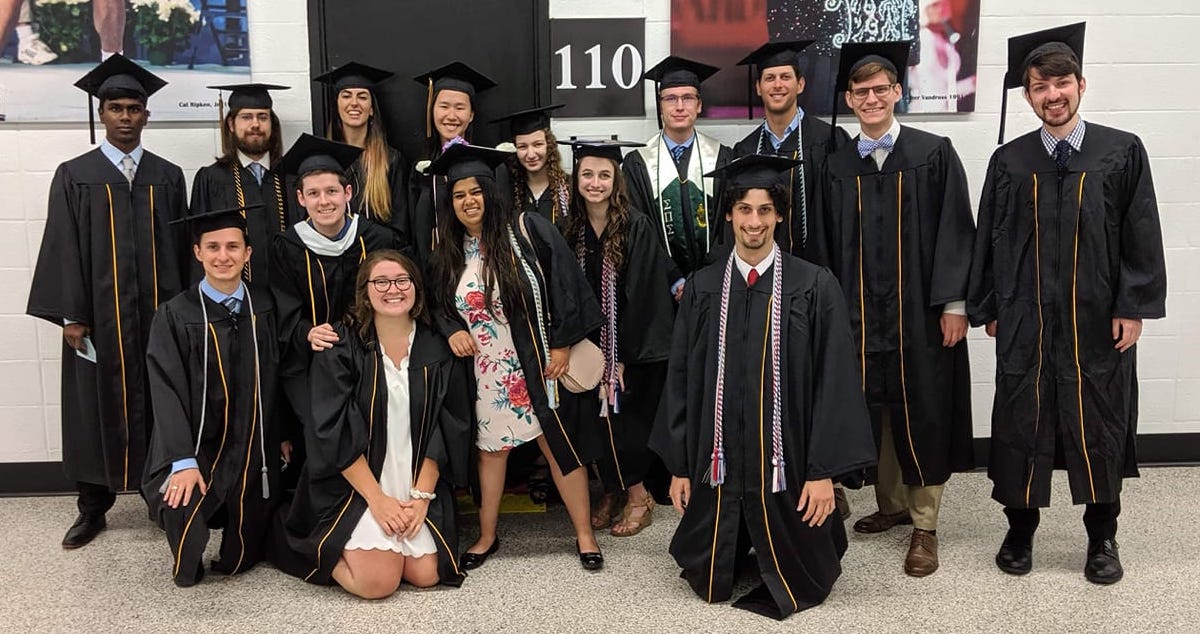
A bitter-sweet moment as the current seniors graduate, including members of our research group who are off to great things in life: Anthony Flores, second from right, is headed to Stanford, and Wenzer Qin, 4th from left in the back row, is headed to MIT for grad school. Ross Dempsey (not shown) graduated earlier during the year and is headed to Princeton. Congratulations!!
JHU undergraduate team wins the International Theoretical Physics Olympiad for Undergraduates. The team -- David Carcamo, Ross Dempsey, Wenzer Qin, and Katherine Xiang -- includes three members affiliated with our group! The olympiad organizers notified the department that "their performance was exceptional, and their achievement is worthy of both recognition and celebration". Very impressive!
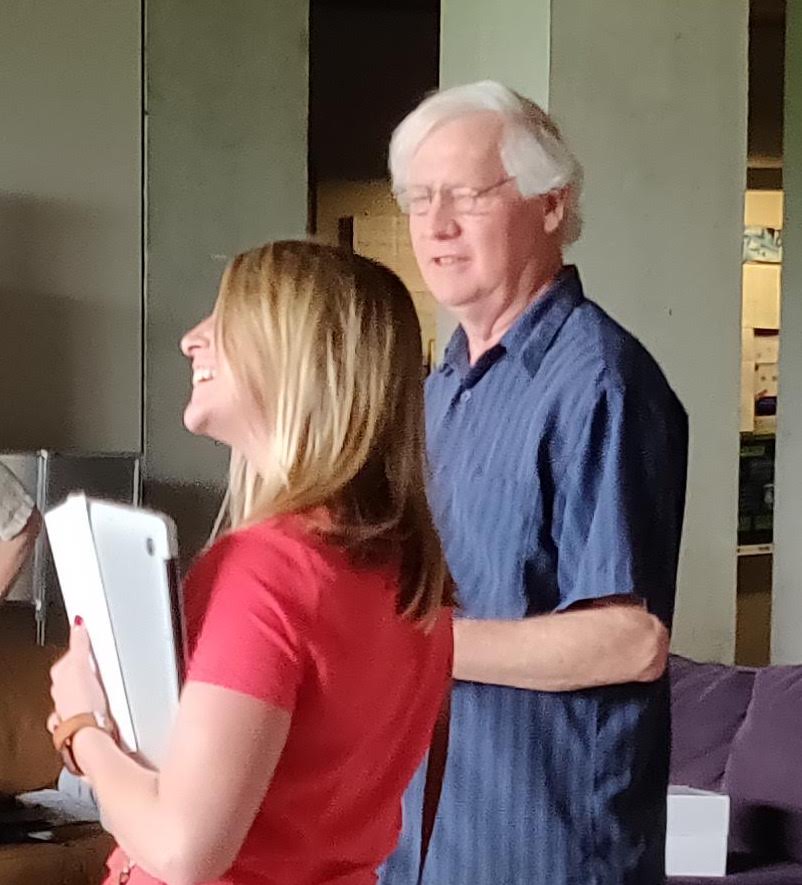
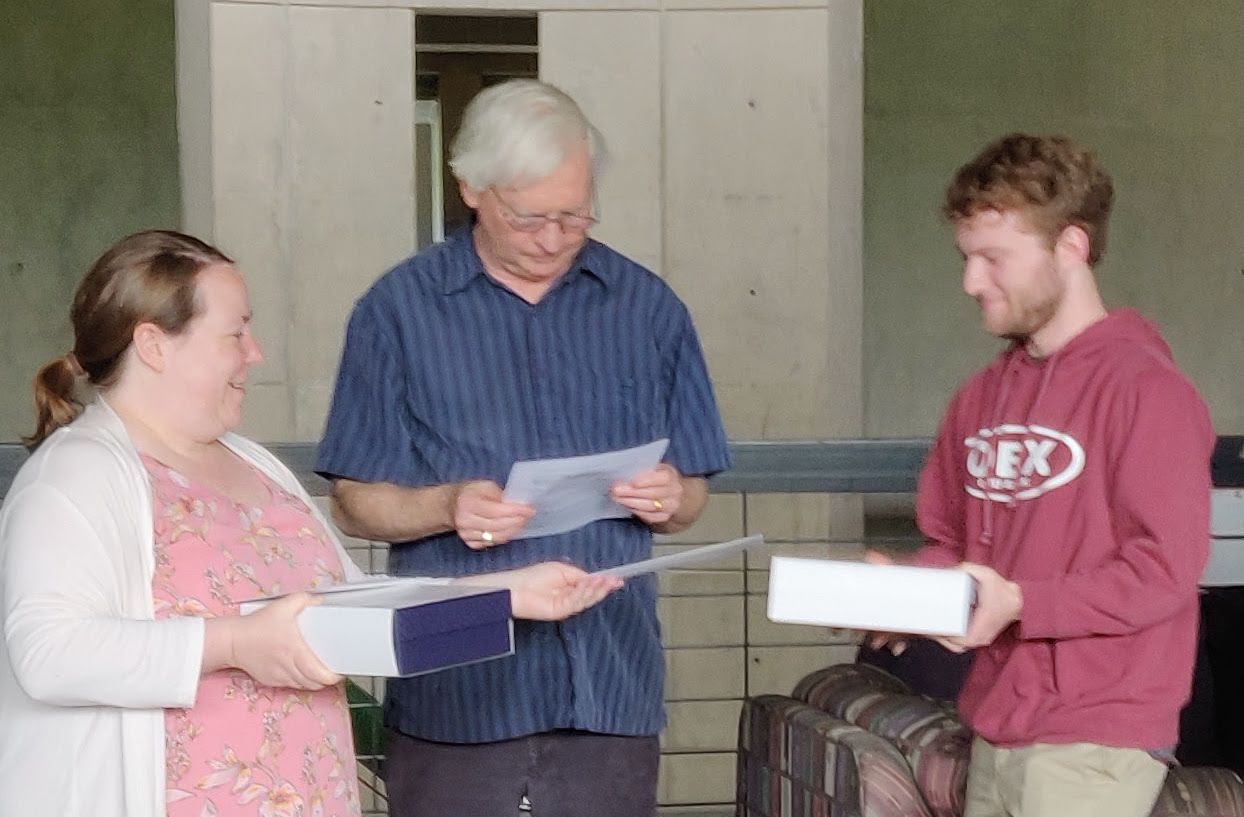
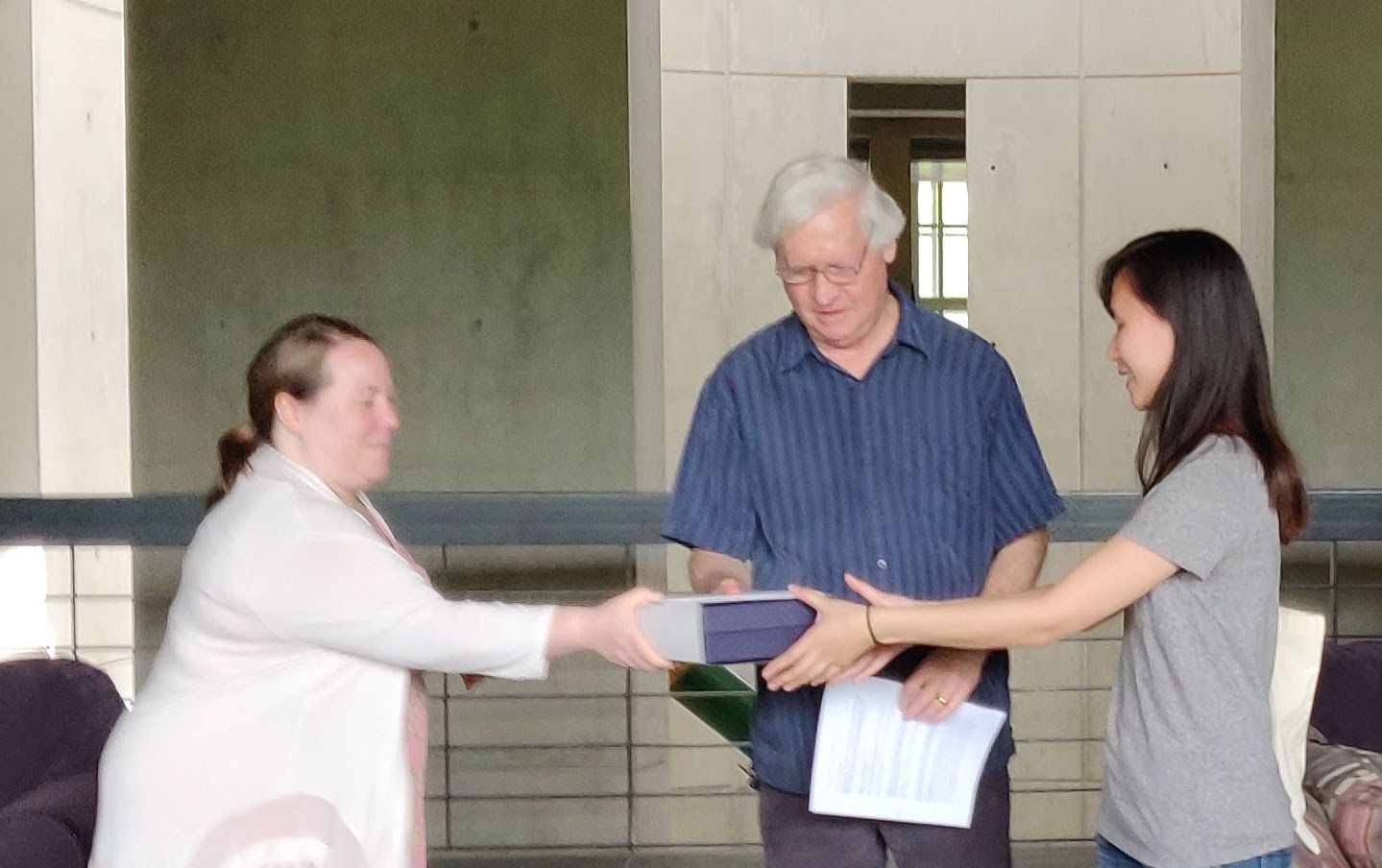
Kirsten Hall, Ross Dempsey and Wenzer Qin, all affiliated with our group, receive major departmental awards. Kirsten receives E.J.Rhee travel award. Wenzer and Ross share the Donald E. Kerr award for the outstanding achievement by an undergraduate student. Both Wenzer and Ross also received NSF fellowships and will be pursuing graduate studies at MIT and Princeton, respectively. Congratulations!
Kirsten Hall, a graduate student in our group, is selected by JHU to attend the Lindau Nobel Laureate Meeting!
Vedant Chandra and Katherine Xiang, both undergraduate students affiliated with our group, receive Dean's Undergraduate Research Award for Summer 2019!
Our 5th Annual Quasar Day! (JHU/Drexel/Princeton) 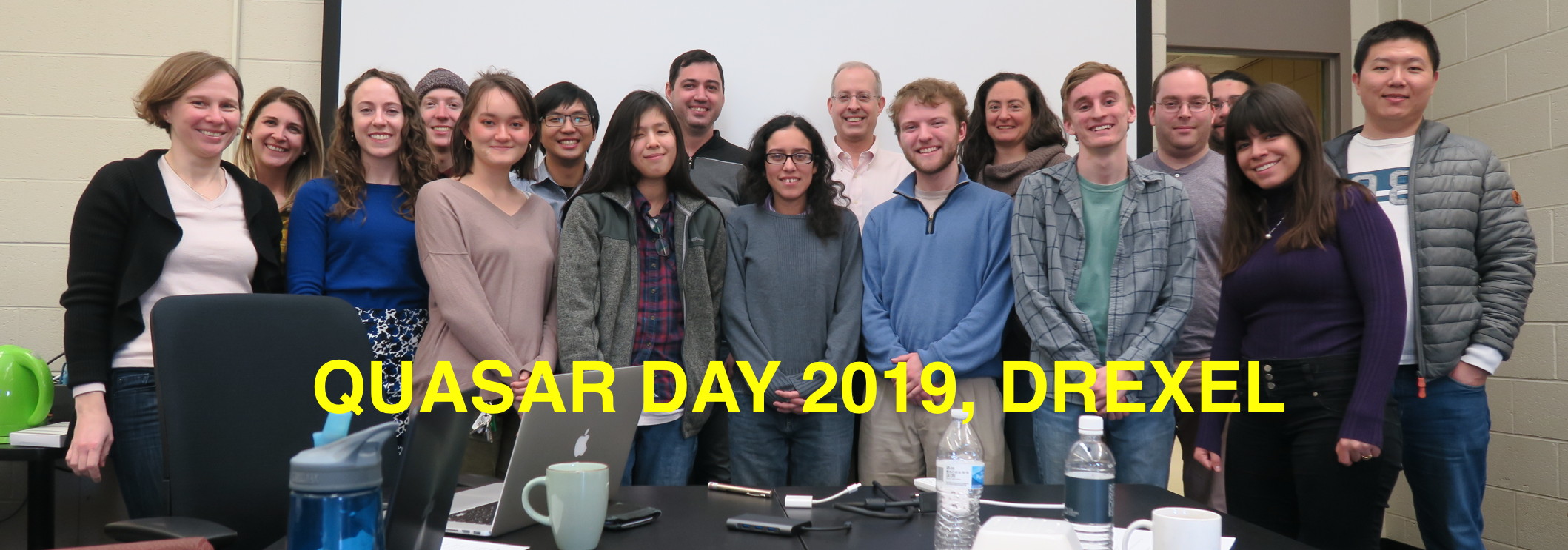
Here is the schedule
Yue Shen (UIUC) and Nadia Zakamska receive a 2018 Scialog Collaborative Innovation Award
Kirsten Hall receives student observing support from the National Radio Astronomical Observatories for the ALMA proposal on which she serves as a Principal Investigator!
Our department is running a search for a Davis Postdoctoral Fellow, to start in Fall 2019: the AAS job ad.
Prospective graduate students wishing to start in Fall 2019 should apply as described here. A detailed research proposal is not required at this stage -- the committee is more interested in hearing about previous academic and research experiences and accomplishments. It is ok to indicate me as the faculty of interest on the statement without contacting me first.
Ross Dempsey successfully defends his Master's research project!
David Rivas, a long-time teaching assistant for Special Relativity / Waves, receives the E.J.Rhee award for flare in teaching. David follows Prasenjit Bose, Anirban Ghosh and Edwin Chan in receiving a teaching award for teaching performance in Special Relativity / Waves. Congratulations!
Kirsten Hall et al. present the result of complex halo-occupation-distribution modeling of faint infrared signal clustered around quasars. This is a unique probe of haloes and large-scale environments of star-forming galaxies at high redshift, which has allowed us to detect galaxy formation down-sizing across a wide range of redshifts for the first time. Ai-Lei Sun et al. discover extended narrow-line regions of quasars in the Hyper Suprime-Cam data using a novel technique, in which the narrow-line emission can be successfully isolated using just broad-band imaging data. Zhicheng He et al. measure the morphology of emission-line regions due to active black holes in the MaNGA survey. Not only are we able to detect the expected bi-conical morphology, but we find that the opening angles and inclinations of ionized regions are correlated with the infrared properties of AGN as expected in the unification model.
Wenzer Qin receives a Barry Goldwater Scholarship! Many congratulations! Wenzer published a paper based on research done in our group in summer 2018. She has also worked in Prof. Gritsan's and Prof. Kamionkowski's groups.
Hsiang-Chih Hwang receives the Gardner Fellowship. Many congratulations!!
Another batch of recently submitted papers: Dempsey and Zakamska conduct a theoretical investigation of the size-luminosity relationship of quasars' narrow emission line regions. We find that in order to produce the ~10 kpc photo-ionized nebulae around powerful quasars, line-emitting clouds must be ionization-bounded, which means that emission-line regions contain 3-30 times more gas than is detectable via the emission lines. Lambrides et al. present the largest study of molecular gas and polycyclic aromatic hydrocarbons using Spitzer spectra, finding that the excitation temperatures of the warm molecular gas are high in galaxies with active nuclei than without, a potential signature of feedback activity. Goulding, Zakamska et al. present an X-ray study of extremely red quasars at high redshift. These objects are among the most highly X-ray obscured quasar populations, yet they are intrinsically luminous in X-ray.
Our group's proposal for Early Release Science with the James Webb Space Telescope was approved! Many congratulations to Principal Investigator Dr. Dominika Wylezalek!
Here are some of the papers submitted by our group members in the last few months: Alexandroff R.M., Zakamska, N.L., et al. in the paper "Spectropolarimetry of high redshift obscured and red quasars" find fascinating spectropolarimetric signatures of equatorial outflows in extremely powerful quasars at the peak epoch of galaxy formation. Wylezalek, D., Zakamska, N.L., et al. develop new methods of "Identification of active galactic nuclei in optical integral field unit surveys" and find that the standard diagnostic diagrams used for distinsguishing star-forming regions from active galactic nuclei based on single-fiber and nuclear spectroscopy need to be re-thought for extended ionized gas regions. Hwang H.-C., Zakamska N.L. et al. discuss "Winds as the origin of radio emission in z=2.5 radio-quiet extremely red quasars" and find that low- and high-redshift obscured and red quasars form one relationship between the kinematics of ionized gas and radio luminosity among the radio-quiet quasars. This is an important clue about the origin of the radio emission in radio-quiet quasars which is not yet well understood. Qin W., Nataf D., Zakamska N.L. et al. investigate a large sample of Mira-type variables in "Mira-based distance to the Galactic Center" and improve the understanding of extinction and metallicity corrections, making Miras more competitive as distance indicators.
Our department is now accepting applications for the Ph.D. program, with a starting date of August 2018, as described here. Our graduate program allows and encourages research rotations. Therefore, prospective students are welcome to indicate in the application that they are interested in joining our group; however, no detailed research proposal is required at this stage, and the admissions committee is more interested in past experiences and accomplishments in research and academics. Example student papers produced by our group are posted throughout this website, and prospective graduate students will have many opportunities to learn about specific projects that will be available in our group in Fall of 2018 after the admission decisions are made in winter 2018 and before committing to our program.
Undergraduate research interns Anthony Flores, Wenzer Qin and Channa Luke present at the Maryland Space Grant research symposium. Wenzer wins a 2nd place in the "Best speaker" competition! More information here.
Congratulations to Dr. Rachael Alexandroff on a successful Ph.D. defense! Dr. Alexandroff will be moving to the University of Toronto as a Canadian National Research Fellow in Fall 2017.
Welcome to the summer interns -- Suri, Anthony, Wenzer and Channa -- with many thanks to the Maryland Space Grant for the funding opportunities!
Postdoctoral supervisors are Dr. Kate Rowlands, Dr. Dominika Wylezalek, and Dr. David Nataf:
4th Annual Quasar Day (JHU/Drexel/Princeton)
Asa Stahl receives Provost's Undergraduate Research Award -- many congratulations! Previous recipients of PURA and DURA (Dean's Award) in our group include Michael Kelly, Kelly Lampayan, Georges Obied and Matthew Hill.
A press release on the discovery of a population of extremely red quasars with powerful outflows, related to the recent paper by Hamann, Zakamska et al. and the previous paper by Zakamska, Hamann et al. Many thanks to collaborator Fred Hamann at UC Riverside for spear-heading the press release.
Prospective graduate students wishing to start in September 2017 can apply as described here. We have lots of new content on the graduate program website, including profiles of recent alumni, graduation stats, and description of the program structure. Prospective students are welcome to indicate in the application that they are interested in joining our group; however, no detailed research proposal is required at this stage, and the admissions committee is more interested in past experiences and accomplishments.
Wylezalek, Schnorr Muller, Zakamska et al. (submitted to MNRAS) use Gemini GMOS intrument to zoom into the centers of nearby active galaxies studied with MaNGA integral field spectroscopic survey, to find strong nuclear outflows likely driven by black hole activity.
Hamann, Zakamska, Ross et al. (accepted to MNRAS) present a population of very intriguing high-redshift red quasars which may be linked to the strong outflow phase of galaxy evolution.
A paper led by Dominika Wylezalek finds observational evidence that specific star formation is suppressed in hosts of quasars with fastest outflows. This could be the long-sought sign of "negative" quasar feedback postulated in galaxy formation theory.
I was very pleased to see my Special Relativity textbook listed in "The Net Advance of Physics" Special Relativity library.
Nadia Zakamska receives Catalyst Award from Johns Hopkins University.
Dr. Dominika Wylezalek has been awarded the Provost's Postdoctoral Fellowship -- congratulations!
The largest catalog of type 2 quasars by Yuan, Strauss and Zakamska with lots of ancillary data is now publicly available here and the paper describing the catalog has been submitted to MNRAS. We are also releasing all [OIII] kinematics from the previous largest catalog by Reyes et al. 2008, Zakamska and Greene 2014.
News from the Department's Award Ceremony: Rachael Alexandroff receives the E.J.Rhee Travel Award and Joseph Cleary receives the Donald E. Kerr Memorial Prize -- congratulations!
Michael Kelly successfully presents his Master's thesis on active galactic nuclei in MaNGA data and will be receiving a Master's degree!
Alexandroff et al. 2016 -- a sensitive radio survey of obscured quasar candidates finds that radio emission in radio quiet quasars is extended on a few kpc scales and that it has steep spectral indices; this observation may be a critical clue in understanding the nature of the radio emission of radio-quiet quasars. Submitted to MNRAS.
Press release on our work on Sunyaev-Zeldovich effect from quasar feedback. Here is the original JHU version.
The video of the public discussion of LIGO results at the Institute for Advanced Study, moderated by Director Robbert Dijkgraaf, with panelists Matias Zaldarriaga, Scott Tremaine, Nadia Zakamska and Doron Kushnir.
Wylezalek et al. 2016 -- a joint study of quasar hosts and their winds with HST and Gemini -- now in press in MNRAS.
Guilin Liu, a former postdoc in our group, will be moving to a faculty position at the University of Science and Technology in China in Fall 2016. Many congratulations!
Obied et al. 2015 -- detection of giant scattering cones in obscured quasars using the HST data and the implications for the unification model of active galaxies -- now in press in MNRAS.
Zakamska et al. 2015, Discovery of extreme [OIII]5007A outflows in high-redshift red quasars -- quasar-driven outflows proceeding at several thousand km/sec, likely on the scales of the host galaxy, submitted to MNRAS
The textbook "Theory of Special Relativity" by N.L.Zakamska is now publicly available.
Stern et al. 2015, Constraining the dynamical importance of hot gas and radiation pressure in quasar outflows using emission line ratios, submitted to ApJ
Evidence for the Thermal Sunyaev-Zel'dovich Effect Associated with Quasar Feedback -- our novel view of quasar feedback in the paper by Devin Crichton et al. 2015
The Department of Physics and Astronomy at Johns Hopkins University is planning to offer a Davis Postdoctoral Fellowship in Astrophysics this year. The position will start in September 2016. Prospective graduate students wishing to start in September 2016 can apply as described here.
Some papers our group submitted in the last couple of months include:
Dr. Dominika Wylezalek becomes inaugural Akbari-Mack Fellow! Congratulations to Dominika, and many thanks to Dr. Akbari and Mr. Mack for their support!
Kelly Lampayan and Georges Obied, both undergraduate researchers in Zakamska research group, share the Donald E. Kerr Memorial Award for outstanding Physics majors. Furthermore, Georges Obied qualifies for the M.A. degree! Prasenjit Bose receives Rowland Prize for innovation and excellence in teaching for outstanding work as teaching assistant in Special Relativity / Waves by Zakamska, following several years of excellence in teaching courses for non-majors. Prasenjit continues the streak of awards to teaching assistants for Special Relativity / Waves, following Edwin Chan (teaching award in May 2013) and Anirban Ghosh (teaching award in May 2014). Congratulations!
Prospective graduate students wishing to start in September 2015 can apply as described here. Here is our flyer, and this is some general information regarding our astrophysics graduate program.
"Nadia L. Zakamska wins the 2014 Newton Lacy Pierce Prize of the American Astronomical Society"
The materials for the IAS public lecture are posted here. |
